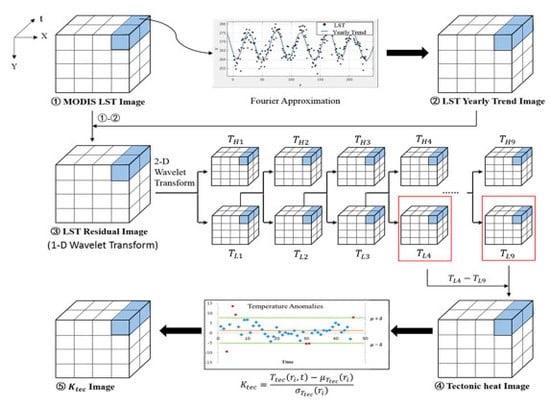A New Algorithm for the Characterization of Thermal Infrared Anomalies in Tectonic Activities
Abstract
1. Introduction
2. Methodology
2.1. Study Area and the Two Examined Earthquake Cases
2.2. Remotely Sensing Data
2.3. Introduction of the New Algorithm
- Step (1)
- Constructing the LST background field and calculating the residuals: The annual trend values were extracted from the sequential LST data, such as the temperature background field, using a harmonic analysis fitted curve method. The detailed introduction on this step is shown in Section 2.3.1. The fitting residual error image (shown in Step ③ of Figure 4) filtered the solar radiation influence and climate change. We then applied a 1-D wavelet transform, and by means of deleting the first order high frequency of wavelet transform, the effect of the short-term meteorological factors could be removed. However, it still consisted of disturbances in the atmosphere and human activities.
- Step (2)
- Spatial filtering to weaken the impacts of the atmosphere and human activities (urban heat island): It was considered in this study that the air masses and urban heat islands did indeed have evident influences on the surface temperature field. Therefore, these disturbance factors needed to be removed or weakened. The spatial scales dominated by these two factors were profoundly different. Generally speaking, an air mass can cover hundreds to thousands of km. However, the influence range of the heat islands only measure tens of km [78]. Therefore, a 2-D wavelet transform technique was used in this study to filter the disturbance factors, and extract the tectonic thermal information. A detailed introduction to this is shown in Section 2.3.2.
- Step (3)
- Presenting the tectonic thermal anomalies information by calculating the value image (shown in ⑤ of Figure 4): Further details of this calculation process are shown in Section 2.3.3.
2.3.1. Construction of the LST Background Field and Calculation of the Residuals
2.3.2. Tectonic Thermal Signal Extraction by Spatial Two-Dimensional Wavelet Filtering for the Purpose of Weakening the Disturbances of the Atmospheric and Human Activities
2.3.3. Expressions of the Tectonic Thermal Infrared Anomalies
3. Results
4. Discussion
4.1. Comparison of the MOD11A2 LST and Ground Air Temperature Data, TIR Anomalies Value
4.2. Comparison of the TTIA and RST Algorithms
4.3. Comparison of TIR Anomalies Based on TTIA and Tectonic Lineations, Topographic Effect
5. Conclusions
- The obtained TIR anomalies based on the new algorithm showed an obvious spatial distribution characteristic along the main faults on the plateau. Therefore, it can be proved that the proposed algorithm had distinctive advantages in removing or weakening the disturbances of the atectonic factors, and was therefore very effective in extracting the tectonic TIR anomalies signals.
- The seismogenic zone was found to be a more effective observation scope for the deeper understanding of the mid- and short-term seismogenic and crust stress change processes.
- The movement trace of the centroid of the TIR anomalies over the entire plateau was helpful in judging the approximate dangerous tectonic regions where major earthquakes may occur in the future.
- At the observe scale of earthquake generating fault zone, before the great earthquake, the fluctuations of the value are significantly more volatile than those in an aseismic period, which indicates that the TIR anomalies in tectonic activities in the event year are more active than those in non-event years.
Author Contributions
Funding
Conflicts of Interest
References
- Freund, F. Pre-earthquake signals: Underlying physical processes. J. Asian Earth Sci. 2011, 41, 383–400. [Google Scholar] [CrossRef]
- Pulinets, S.A.; Dunajecka, M.A. Specific variations of air temperature and relative humidity around the time of Michoacan earthquake M8.1 Sept. 19, 1985 as a possible indicator of interaction between tectonic plates. Tectonophysics 2007, 431, 221–230. [Google Scholar] [CrossRef]
- Tronin, A.A.; Biagi, P.F.; Molchanov, O.A.; Khatkevich, Y.M.; Gordeev, E.I. Temperature variations related to earthquakes from simultaneous observation at the ground stations and by satellites in Kamchatka area. Phys. Chem. Earth 2004, 29, 501–506. [Google Scholar] [CrossRef]
- Roeloffs, E.A. Hydrologic precursors to earthquakes: A review. Pure Appl. Geophys. 1988, 126, 177–209. [Google Scholar] [CrossRef]
- Tronin, A.A. Remote sensing and earthquakes: A review. Phys. Chem. Earth Parts A/B/C 2006, 31, 138–142. [Google Scholar] [CrossRef]
- Qiang, Z.J.; Yao, Q.L.; Wei, L.J.; Zeng, Z.X. The characteristic of current stress hot field by satellite thermal infrared image in china. Acta Geosci. Sin. 2009, 30, 873–884. [Google Scholar]
- Choudhury, S.; Dasgupta, S.; Saraf, A.K.; Panda, S. Remote sensing observations of pre-earthquake thermal anomalies in Iran. Int. J. Remote Sens. 2006, 27, 4381–4396. [Google Scholar] [CrossRef]
- Ouzounov, D.; Bryant, N.; Logan, T.; Pulinets, S.; Taylor, P. Satellite thermal IR phenomena associated with some of the major earthquakes in 1999–2003. Phys. Chem. Earth Parts A/B/C 2006, 31, 154–163. [Google Scholar] [CrossRef]
- Saraf, A.K.; Rawat, V.; Banerjee, P.; Choudhury, S.; Panda, S.K.; Dasgupta, S.; Das, J.D. Satellite detection of earthquake thermal infrared precursors in Iran. Nat. Hazards 2008, 47, 119–135. [Google Scholar] [CrossRef]
- Saraf, A.K.; Rawat, V.; Das, J.; Zia, M.; Sharma, K. Satellite detection of thermal precursors of Yamnotri, Ravar and Dalbandin earthquakes. Nat. Hazards 2011, 61, 861–872. [Google Scholar] [CrossRef]
- Yao, Q.-L.; Qiang, Z.-J. Thermal infrared anomalies as a precursor of strong earthquakes in the distant future. Nat. Hazards 2012, 62, 991–1003. [Google Scholar] [CrossRef]
- Qiang, Z.J.; Xu, X.D.; Dian, C.G. Satellite thermal infrared anomalies—The pre-earthquake precursors. Chin. Sci. Bull. 1990, 35, 1324–1327. [Google Scholar]
- Piscini, A.; Santis, A.; Marchetti, D.; Cianchini, G. A Multi-parametric Climatological Approach to Study the 2016 Amatrice-Norcia (Central Italy) Earthquake Preparatory Phase. Pure Appl. Geophys. 2017, 174, 3673–3688. [Google Scholar] [CrossRef]
- Yadav, K.S.; Karia, S.P.; Pathak, K.N. Removal of solar radiation effect based on nonlinear data processing technique for seismo-ionospheric anomaly before few earthquakes. Geomat. Nat. Hazards Risk 2015, 7, 1147–1161. [Google Scholar] [CrossRef]
- Freund, F.; Keefner, J.; Mellon, J.J.; Post, R.; Takeuchi, A.; Lau, B.W.S.; La, A.; Ouzounov, D. Enhanced mid-infrared emission from igneous rocks under stress. Geophys. Res. Abstr. 2005, 7, 09568. [Google Scholar]
- Ishibashi, K. Two categories of earthquake precursors, physical and tectonic, and their roles in intermediate-term earthquake prediction. Pure Appl. Geophys. 1988, 126, 687–700. [Google Scholar] [CrossRef]
- Qiang, Z.J.; Xu, X.-D.; Dian, C.-G. Thermal infrared anomaly—Precursor of impending earthquakes. Chin. Sci. Bull. 1991, 36, 319–323. [Google Scholar] [CrossRef]
- Chen, S.Y.; Ma, J.; Liu, L.Q.; Liu, P. An enhancive phenomenon of thermal infrared radiation prior to Pakistan earthquake. Prog. Nat. Sci. 2006, 16, 1487–1490. [Google Scholar]
- Kai, Q. Preliminary analysis of surface temperature anomalies that preceded the two major Emilia 2012 earthquakes (Italy). Ann. Geophys. 2012, 55, 823–828. [Google Scholar]
- Bhardwaj, A.; Singh, S.; Sam, L.; Bhardwaj, A.; Martín-Torres, F.J.; Singh, A.; Kumar, R. MODIS-based estimates of strong snow surface temperature anomaly related to high altitude earthquakes of 2015. Remote Sens. Environ. 2017, 188, 1–8. [Google Scholar] [CrossRef]
- Genzano, N.; Aliano, C.; Corrado, R.; Filizzola, C.; Lisi, M.; Mazzeo, G.; Paciello, R.; Pergola, N.; Tramutoli, V. RST analysis of MSG-SEVIRI TIR radiances at the time of the Abruzzo 6 April 2009 earthquake. Nat. Hazard Earth Syst. Sci. Discuss. 2009, 9, 2073–2084. [Google Scholar] [CrossRef]
- Tramutoli, V. Robust Satellite Techniques (RST) for Natural and Environmental Hazards Monitoring and Mitigation: Theory and Applications. In Proceedings of the 2007 International Workshop on the Analysis of Multi-temporal Remote Sensing Images, Leuven, Belgium, 18–20 July 2007; pp. 1–6. [Google Scholar]
- Saraf, A.K.; Rawat, V.; Choudhury, S.; Dasgupta, S.; Das, J. Advances in understanding of the mechanism for generation of earthquake thermal precursors detected by satellites. Int. J. Appl. Earth Obs. Geoinf. 2009, 11, 373–379. [Google Scholar] [CrossRef]
- Tronin, A.A. Satellite thermal surveyâ a new tool for the study of seismoactive regions. Int. J. Remote Sens. 1996, 17, 1439–1455. [Google Scholar] [CrossRef]
- Tramutoli, V. Robust AVHRR techniques (RAT) for environmental monitoring: Theory and applications. Proc. SPIE 1998, 3496, 101–113. [Google Scholar]
- Tronin, A.A. Satellite thermal survey application for earthquake prediction. In Atmospheric and Ionospheric Electromagnetic Phenomena Associated with Earthquakes; Hayakawa, M., Ed.; Terrapub: Tokyo, Japan, 1999; pp. 717–746. [Google Scholar]
- Qiang, Z.J.; Dian, C.G.; Li, L.Z. Satellite thermal infrared precursors of two moderate-strong earthquakes in Japan and impending earthquake prediction. In Atmospheric and Ionospheric Electromagnetic Phenomena Associated with Earthquakes; Hayakawa, M., Ed.; Terrapub: Tokyo, Japan, 1999; pp. 747–750. [Google Scholar]
- Hayakawa, M.; Molchanov, O.A.; Kodama, T.; Tanaka, T.; Igarashi, T. On a possibility to monitor seismic activity using satellites. Adv. Space Res. 2000, 26, 993–996. [Google Scholar] [CrossRef]
- Tronin, A.A. Thermal IR satellite sensor data application for earthquake research in China. Int. J. Remote Sens. 2000, 21, 3169–3177. [Google Scholar] [CrossRef]
- Tronin, A.A. Thermal satellite data for earthquake research. In Proceedings of the IEEE 2000 International Geoscience and Remote Sensing Symposium, Honolulu, HI, USA, 24–28 July 2000; pp. 2703–2705. [Google Scholar]
- Tramutoli, V.; Bello, G.D.; Pergola, N.; Piscitelli, S. Robust satellite techniques for remote sensing of seismically active areas. Ann. Geophys. 2001, 44, 295–312. [Google Scholar]
- Tronin, A.A.; Hayakawa, M.; Molchanov, O.A. Thermal IR satellite data application for earthquake research in Japan and China. J. Geodyn. 2002, 33, 519–534. [Google Scholar] [CrossRef]
- Filizzola, C.; Pergola, N.; Pietrapertosa, C.; Tramutoli, V. Robust satellite techniques for seismically active areas monitoring: A sensitivity analysis on September 7, 1999 Athens’s earthquake. Phys. Chem. Earth 2004, 29, 517–527. [Google Scholar] [CrossRef]
- Ouzounov, D.; Freund, F. Mid-infrared emission prior to strong earthquakes analyzed by remote sensing data. Adv. Space Res. 2004, 33, 268–273. [Google Scholar] [CrossRef]
- Saraf, A.K.; Choudhury, S. Cover: NOAA-AVHRR detects thermal anomaly associated with the 26 January 2001 Bhuj earthquake, Gujarat, India. Int. J. Remote Sens. 2005, 26, 1065–1073. [Google Scholar] [CrossRef]
- Saraf, A.K.; Choudhury, S. Cover: Satellite detects surface thermal anomalies associated with the Algerian earthquakes of May 2003. Int. J. Remote Sens. 2005, 26, 2705–2713. [Google Scholar] [CrossRef]
- Saraf, A.K.; Choudhury, S. Thermal remote sensing technique in the study of pre-earthquake thermal anomalies. J. Ind. Geophys. Union 2005, 9, 197–207. [Google Scholar]
- Tramutoli, V.; Cuomo, V.; Filizzola, C.; Pergola, N.; Pietrapertosa, C. Assessing the potential of thermal infrared satellite surveys for monitoring seismically active areas: The case of Kocaell (Izmit) earthquake, August 17, 1999. Remote Sens. Environ. 2005, 96, 409–426. [Google Scholar] [CrossRef]
- Surkov, V.V.; Pokhotelov, O.A.; Parrot, M.; Hayakawa, M. On the origin of stable IR anomalies detected by satellites above seismo-active regions. Phys. Chem. Earth 2006, 31, 164–171. [Google Scholar] [CrossRef]
- Panda, S.K.; Choudhury, S. MODIS land surface temperature data detects thermal anomaly preceding 8 October 2005 Kashmir earthquake. Int. J. Remote Sens. 2007, 28, 4587–4596. [Google Scholar] [CrossRef]
- Rawat, V.; Saraf, A.K.; Sharma, K.; Shujat, Y. Anomalous land surface temperature and outgoing long-wave radiation observations prior to earthquakes in India and Romania. Nat. Hazards 2011, 59, 33–46. [Google Scholar] [CrossRef]
- Lisi, M.; Filizzola, C.; Genzano, N.; Paciello, R.; Pergola, N.; Tramutoli, V. Reducing atmospheric noise in RST analysis of TIR satellite radiances for earthquakes prone areas satellite monitoring. Phys. Chem. Earth Parts A/B/C 2015, 85–86, 87–97. [Google Scholar] [CrossRef]
- Ma, J.; Chen, S.; Hu, X.; Liu, P.; Liu, L. Spatial-temporal variation of the land surface temperature field and present-day tectonic activity. Geosci. Front. 2010, 1, 57–67. [Google Scholar] [CrossRef]
- Qiang, Z.J.; Kong, L.C.; Guo, M.H. The experimental study on the satellite thermal infrared heating mechanism. Acta Seismol. Sin. 1997, 19, 197–201. [Google Scholar]
- Wu, L.X.; Liu, S.J.; Wu, Y.H.; Li, Y.Q. Remote Sensing–Rock Mechanics (I)—Laws of thermal infrared radiation from fracturing of discontinuous jointed faults and its meanings for tectonic earthquake omens. Chin. J. Rock Mech. Eng. 2004, 23, 24–30. [Google Scholar]
- Wu, L.X.; Liu, S.J.; Wu, Y.H.; Li, Y.Q. Remote Sensing–Rock Mechanics (II)—Laws of thermal infrared radiation from viscosity-sliding of bi-sheared faults and its meanings for tectonic earthquake omens. Chin. J. Rock Mech. Eng. 2004, 23, 192–198. [Google Scholar]
- Wu, L.X.; Liu, S.J.; Wu, Y.H.; Li, Y.Q. Remote Sensing–Rock Mechanics (IV)—Laws of thermal infrared radiation from compressively-sheared fracturing of rock and its meanings for tectonic earthquake omens. Chin. J. Rock Mech. Eng. 2004, 23, 539–544. [Google Scholar]
- Piroddi, L.; Ranieri, G. Night Thermal Gradient: A New Potential Tool for Earthquake Precursors Studies. An Application to the Seismic Area of L’Aquila (Central Italy). IEEE J. STARS 2012, 5, 307–312. [Google Scholar] [CrossRef]
- Piroddi, L.; Ranieri, G.; Freund, F.; Trogu, A. Geology, tectonics and topography underlined by L’Aquila earthquake TIR precursors. Geophys. J. Int. 2014, 197, 1532–1536. [Google Scholar] [CrossRef]
- Ma, J.; Sherman, S.; Guo, Y.S. Recognition of stress state in the meta-instability stage before earthquake—Study on the evolution of temperature field in fault deformation with 5° bend. Sci. Chin. Earth Sci. 2012, 42, 633–645. [Google Scholar]
- Liu, P.; Ma, J.; Liu, L. An experimental study on variation of thermal fields during the deformation of a compressive en echelon fault set. Prog. Nat. Sci. 2007, 17, 298–304. [Google Scholar]
- Wu, L.; Liu, S.; Wu, Y. Precursors for rock fracturing and failure—Part II: IRR T-Curve abnormalities. Int. J. Rock Mech. Min. 2006, 43, 483–493. [Google Scholar] [CrossRef]
- Wu, L.; Liu, S.; Wu, Y. Precursors for rock fracturing and failure—Part I: IRR image abnormalities. Int. J. Rock Mech. Min. 2006, 43, 473–482. [Google Scholar] [CrossRef]
- Freund, F. Charge generation and propagation in igneous rocks. J. Geodyn. 2002, 33, 543–570. [Google Scholar] [CrossRef]
- Singh, R.P.; Kumar, J.S.; Zlotnicki, J.; Kafatos, M. Satellite detection of carbon monoxide emission prior to the Gujarat earthquake of 26 January 2001. Appl. Geochem. 2010, 25, 580–585. [Google Scholar] [CrossRef]
- Qiang, Z.; Dian, C.; Li, L.; Xu, M.; Ge, F.; Liu, T.; Zhao, Y.; Guo, M. Atellitic thermal infrared brightness temperature anomaly image—Short-term and impending earthquake precursors. Sci. China Ser. D 1999, 42, 313–324. [Google Scholar] [CrossRef]
- Qiang, Z.J.; Xu, X.D.; Dian, C.G. Case 27 thermal infrared anomaly precursor of impending earthquakes. Pure Appl. Geophys. 1991, 149, 319–323. [Google Scholar] [CrossRef]
- Chen, M.H.; Deng, Z.H.; MA, X.J.; Tao, J.L.; Wang, Y. Application of the inside-outside temperature relation analysis method in study on satellite infrared anomalies prior to earthquake. Seismol. Geol. 2007, 29, 863–872. [Google Scholar]
- Guo, W.Y.; Shan, X.J.; Ma, J. Discuss on the anomalous increase of ground temperature along the seismogenic fault before the Kunlunshan Ms8.1 earthquake in 2001. Seismol. Geol. 2004, 26, 548–556. [Google Scholar]
- Eleftheriou, A.; Filizzola, C.; Genzano, N.; Lacava, T.; Lisi, M.; Paciello, R.; Pergola, N.; Vallianatos, F.; Tramutoli, V. Long-term RST analysis of anomalous TIR sequences in relation with earthquakes occurred in Greece in the period 2004–2013. Pure Appl. Geophys. 2015, 173, 285–303. [Google Scholar] [CrossRef]
- Pergola, N.; Aliano, C.; Coviello, I.; Filizzola, C. Using RST approach and EOS-MODIS radiances for monitoring seismically active regions: A study on the 6 April 2009 Abruzzo earthquake. Nat. Hazards Earth Syst. Sci. 2010, 10, 239–249. [Google Scholar] [CrossRef]
- Blackett, M.; Wooster, M.J.; Malamud, B.D. Exploring land surface temperature earthquake precursors: A focus on the Gujarat (India) earthquake of 2001. Geophys. Res. Lett. 2011, 38. [Google Scholar] [CrossRef]
- Bellaoui, M.; Hassini, A.; Bouchouicha, K. Pre-seismic anomalies in remotely sensed land surface temperature measurements: The case study of 2003 Boumerdes earthquake. Adv. Space Res. 2017, 59, 2645–2657. [Google Scholar] [CrossRef]
- Chen, S.Y.; Liu, P.X.; Liu, L.Q.; Jin, M.A.; Chen, G.Q. Wavelet analysis of thermal infrared radiation of land surface and its implication in the study of current tectonic activities. Chin. J. Geophys. 2006, 49, 717–723. [Google Scholar] [CrossRef]
- Chen, S.Y. A Study on the Quantitative Thermal Infrared Remote Sensing Method for Extracting Information of Current Tectonic Activity. Ph.D. Thesis, Institute of Geology, China Earthquake Administration, Beijing, China, August 2006. [Google Scholar]
- Saradjian, M.R.; Akhoondzadeh, M. Thermal anomalies detection before strong earthquakes (M > 6.0) using interquartile, wavelet and kalman filter methods. Nat. Hazards Earth Syst. 2011, 11, 1099–1108. [Google Scholar] [CrossRef]
- Wang, Y.L.; Chen, G.H.; Kang, L.C.; Zhang, Q. Earthquake-related thermal infrared abnormity detection with wavelet packet decomposition. Prog. Geophys. 2008, 23, 368–374. [Google Scholar]
- Zhang, Y.S.; Guo, X.; Zhong, M.J.; Shen, W.R.; Li, W.; He, B. The satellite thermal infrared brightness temperature changes of Wenchuan earthquake. Chin. Sci. Bull. 2010, 55, 904–910. [Google Scholar]
- Zhang, X.; Zhang, Y.S.; Wei, C.X.; Tian, X.F.; Feng, H.W. Thermal infrared anomaly prior to Yiliang of Yunnan Ms5.7 earthquake. China Earthq. Eng. J. 2013, 35, 171–176. [Google Scholar]
- Chen, S.Y.; Jin, M.A.; Liu, P.X.; Liu, L.Q. A study on the normal annual variation field of land surface temperature in China. Chin. J. Geophys. 2009, 52, 2273–2281. [Google Scholar] [CrossRef]
- Li, Y.S. Numerical Approximation, Location of Publisher; People’s Education Press: Beijing, China, 1978. [Google Scholar]
- Li, D. Temporal-Spatial Structure of Intraplate Uplift in the Qinghai-Tibet Plateau. Acta Geol. Sin. (Engl. Ed.) 2010, 84, 105–134. [Google Scholar] [CrossRef]
- Cui, J.W.; Li, P.W.; Li, L. Uplift of the Qinhai-Tibet Plateau: Lithospheric structure and structural geomorphology of the Qinghai-Tibet Plateau. Cont. Dyn. 2001, 6, 29–37. [Google Scholar]
- Zhang, P.Z.; Deng, Q.D.; Zhan, G.M.; Ma, J. The activities of strong earthquakes and tectonic activities in China. Sci. China Ser. D 2003, 33, 12–20. [Google Scholar]
- Zhang, P.; Deng, Q.; Zhang, G.; Ma, J.; Gan, W.; Min, W.; Mao, F.; Wang, Q. Active tectonic blocks and strong earthquakes in the continent of China. Sci. Chin. 2003, 46, 13–24. [Google Scholar]
- Liu, X.; Ying, S.D.; Ma, J. Present-day deformation and stress state of Longmenshan fault from GPS results—Comparative research on active faults in Sichuan-Yunnan region. Chin. J. Geophys. 2014, 57, 1091–1100. [Google Scholar]
- Baiocchi, V.; Zottele, F.; Dominici, D. Remote sensing of urban microclimate change in L’Aquila city (Italy) after post-earthquake depopulation in an open source GIS environment. Sensors 2017, 17, 404. [Google Scholar] [CrossRef] [PubMed]
- Trigub, R.M.; Bellinsky, E.S. Fourier Analysis and Approximation of Functions; Kluwer Academic Publishers: Dordrech, The Netherlands, 2004. [Google Scholar]
- Zou, J.; Chen, J.; Geng, Z.M. Theory and application of optimal Fourier-Filter for waveform recovery. J. Vib. Eng. 2002, 15, 239–242. [Google Scholar]
- Liang, Z.G. Harmonic analysis of periodic signal. Meas. Technol. 2003, 2, 3–5. [Google Scholar]
- Lyon, M.; Picard, J. The Fourier approximation of smooth but non-periodic functions from unevenly spaced data. Adv. Comput. Math. 2014, 40, 1073–1092. [Google Scholar] [CrossRef]
- Zhang, X.; Zhang, R. The technology research in decomposition and reconstruction of image based on two-dimensional wavelet transform. In Proceedings of the IEEE International Conference on Fuzzy Systems and Knowledge Discovery, Changsha, China, 27–29 August 2000; pp. 1998–2000. [Google Scholar]
- Chen, S.Y.; Ma, W.; Liu, P.Y.; Liu, L.Q.; Yan, X.Y. Exploring the coseismic thermal response of Wenchuan earthquake using TERRA and AQUA satellite surface temperature. Chin. J. Geophys. 2013, 56, 3788–3799. [Google Scholar]
- Karl, T.R.; Diaz, H.F.; Kukla, G. Urbanization: Its detection and effect in the United States climate record. J. Clim. 1988, 1, 1099–1123. [Google Scholar] [CrossRef]
- Yuan, W.; Zou, L.Z.; Sun, J.Q. Temporal and Spatial Variation Characteristics of Summer Temperature in Xinjiang from 1951 to 2005 and Its Relationship with Atmospheric Circulation. J. Glaciol. Geocryol. 2009, 31, 801–807. [Google Scholar]
- Hou, W.; Sun, S.P.; Zhang, S.X.; Zhao, J.H.; Feng, G.L. Seasonal division of atmospheric circulation in East Asia and its temporal and spatial variation characteristics. Act Phys. Sin. 2011, 60, 781–789. [Google Scholar]
- Peng, S.L.; Zhou, K.; Ye, Y.H.; Su, J. Research progress in urban heat island effect. J. Ecol. Environ. 2005, 14, 574–579. [Google Scholar]
- Hu, Y.M.; Xu, C.G.; Bu, R.C.; Chang, W.; Zhang, Y.S. Application of Rs and Gis in Urban Heat Island Effect Research. Environ. Prot. Sci. 2002, 28, 1–3. [Google Scholar]
- Li, G.Q. Theories and Methods of Spatio-Temporal Outliers Detection. Ph.D. Thesis, Central South University, Changsha, China, 2009. [Google Scholar]
- Hawkins, D.M. Identification of Outliers; Chapman and Hall: London, UK, 1980; pp. 321–328. [Google Scholar]
- Jiang, S.Y.; Li, Q.H.; Li, K.L.; Wang, H. Glof: A new approach for mining local outlier. In Proceedings of the International Conference on Machine Learning and Cybernetics, Xi’an, China, 5 November 2003; Volume 151, pp. 157–162. [Google Scholar]
- Rousseeuw, P.J.; Leroy, A.M. Robust Regression and Outlier Detection; Wiley-Interscience: New York, NY, USA, 2003; pp. 260–261. [Google Scholar]
- Marchetti, D.; Akhoondzadeh, M. Analysis of Swarm satellites data showing seismoionospheric anomalies around the time of the strong Mexico (Mw =8.2) earthquake of 08 September 2017. Adv. Space Res. 2018, 62, 614–623. [Google Scholar] [CrossRef]
- Zhang, X.; Fidani, C.; Huang, J.; Shen, X. Burst increases of precipitating electrons recorded by the DEMETR satellite before strong earthquakes. Nat. Hazards Earth. Syst. 2013, 13, 197–209. [Google Scholar] [CrossRef]
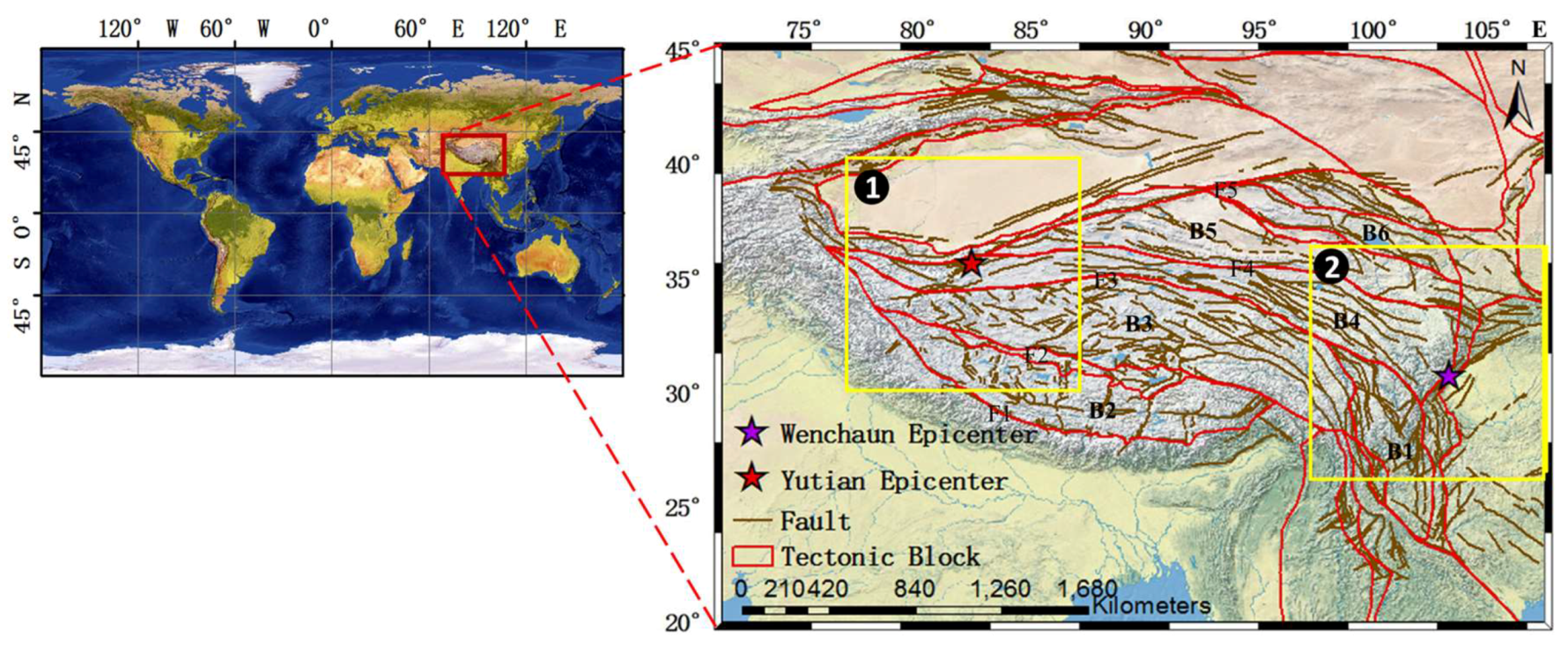
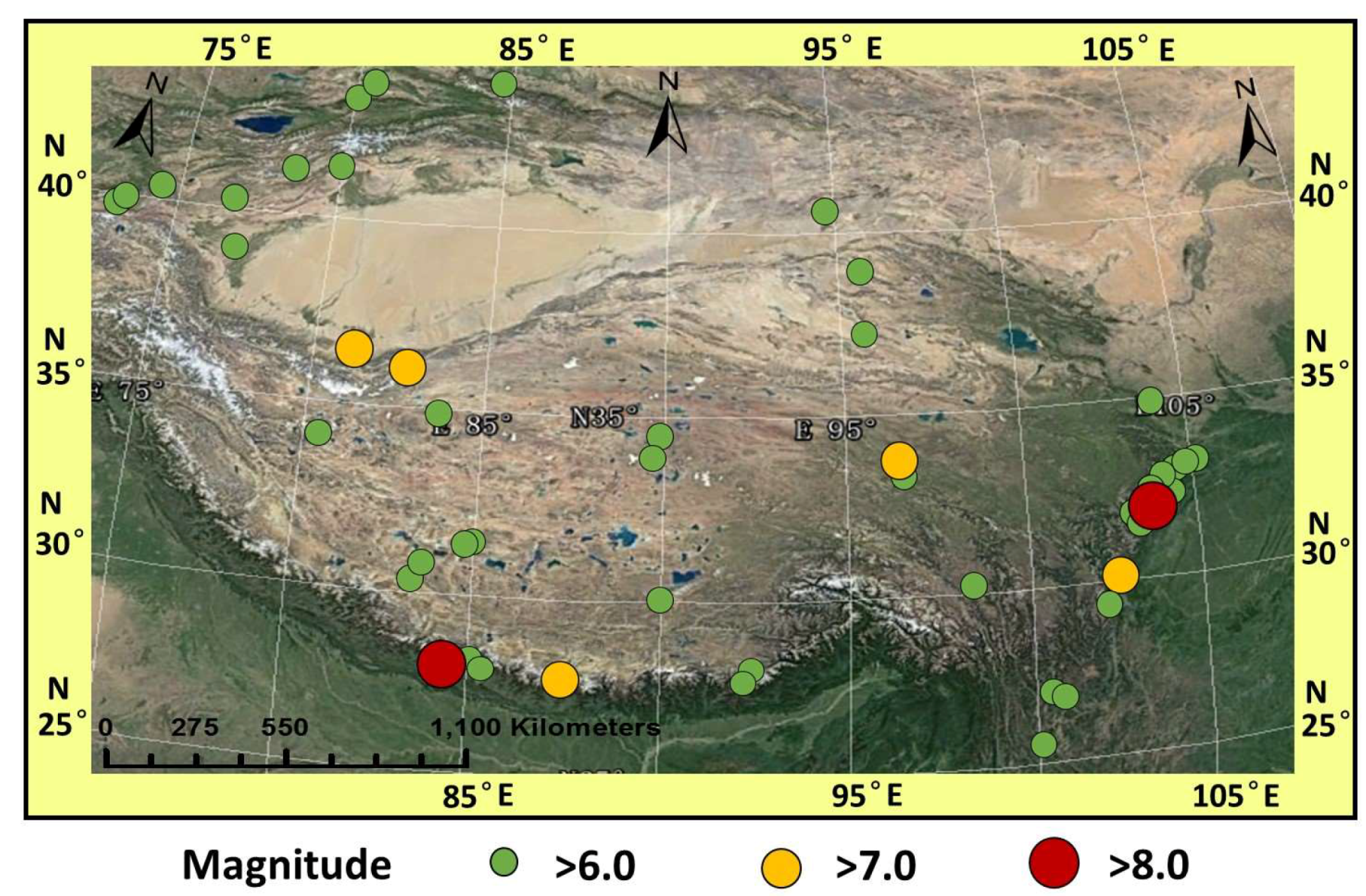
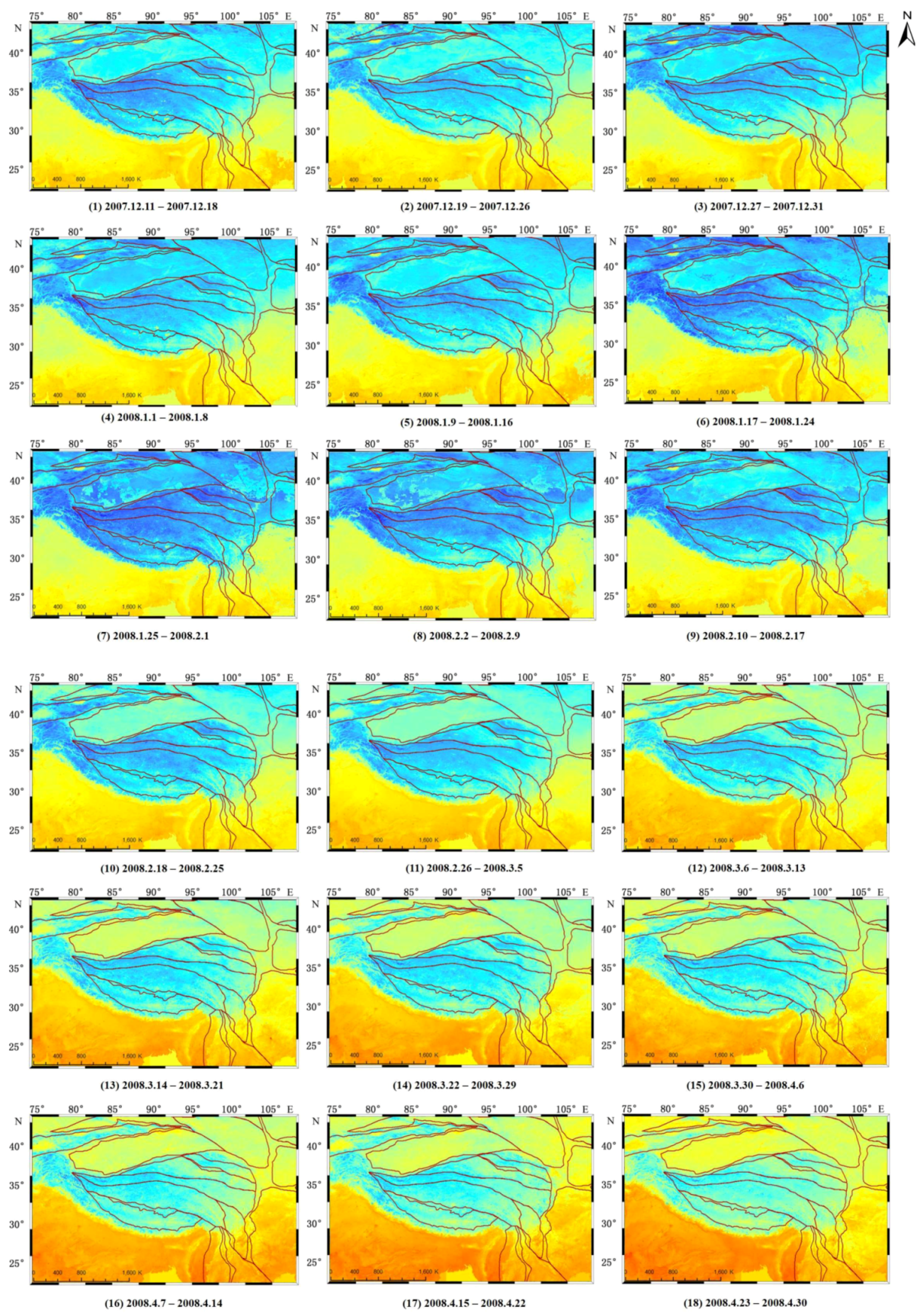
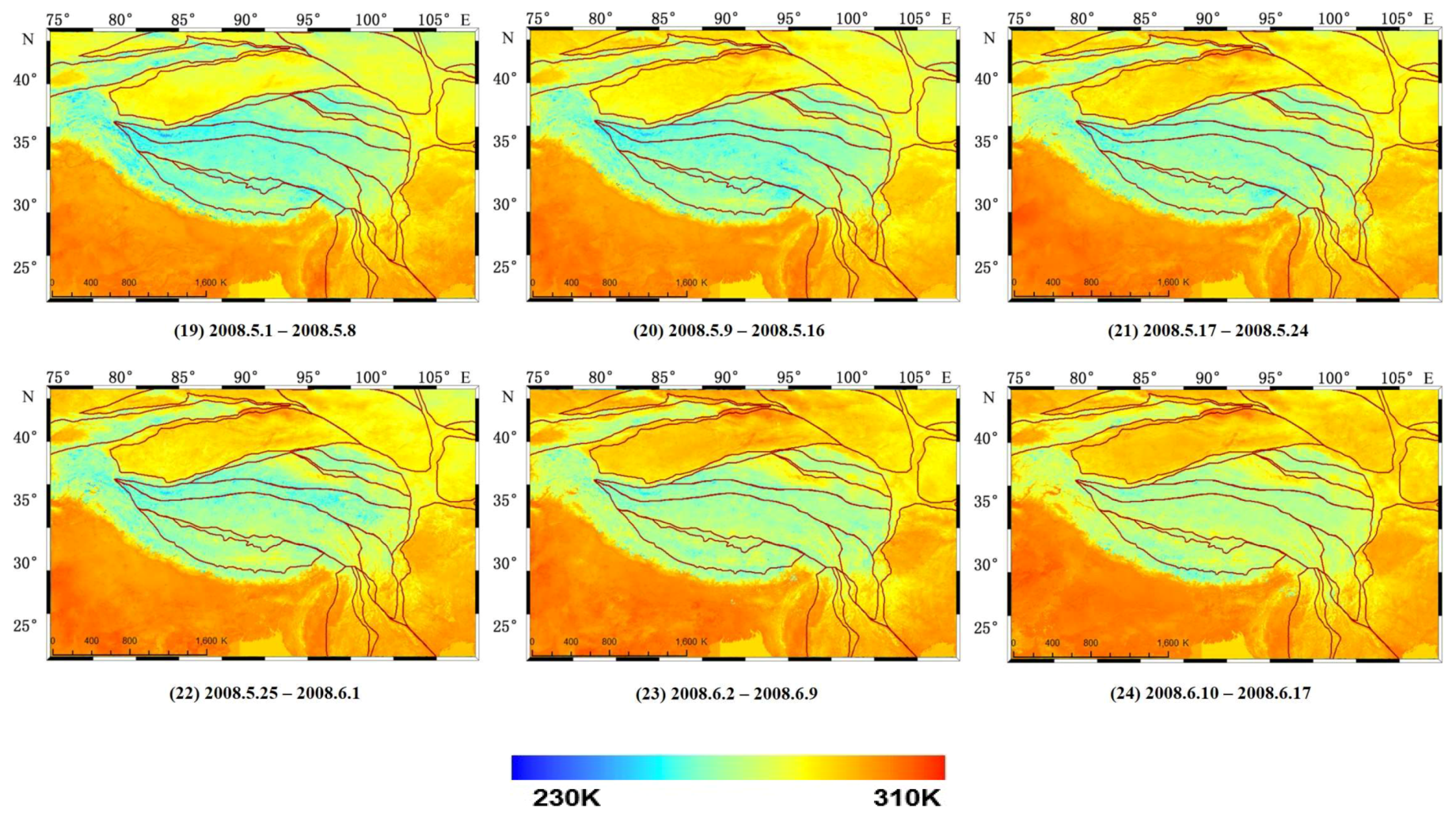
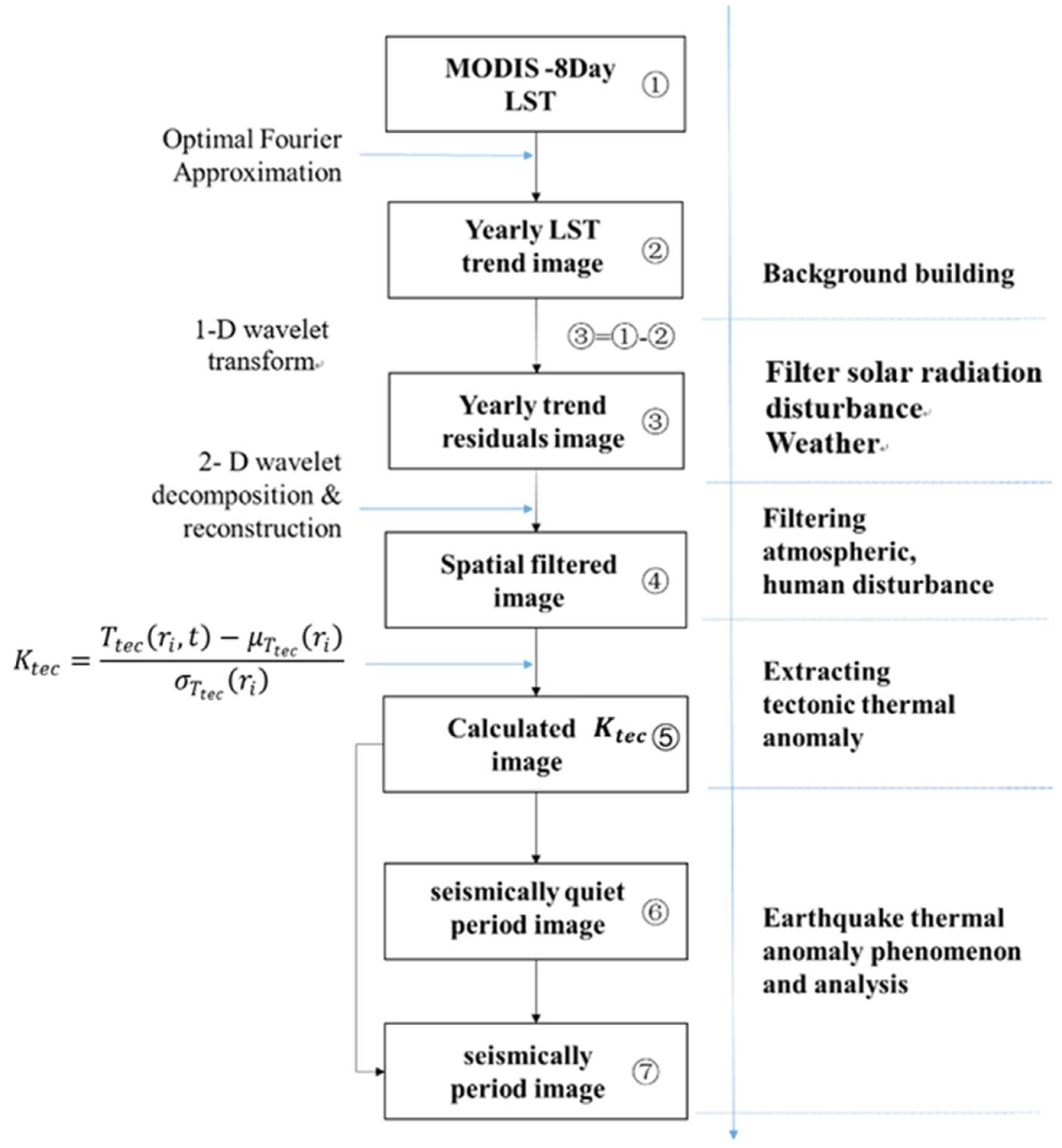
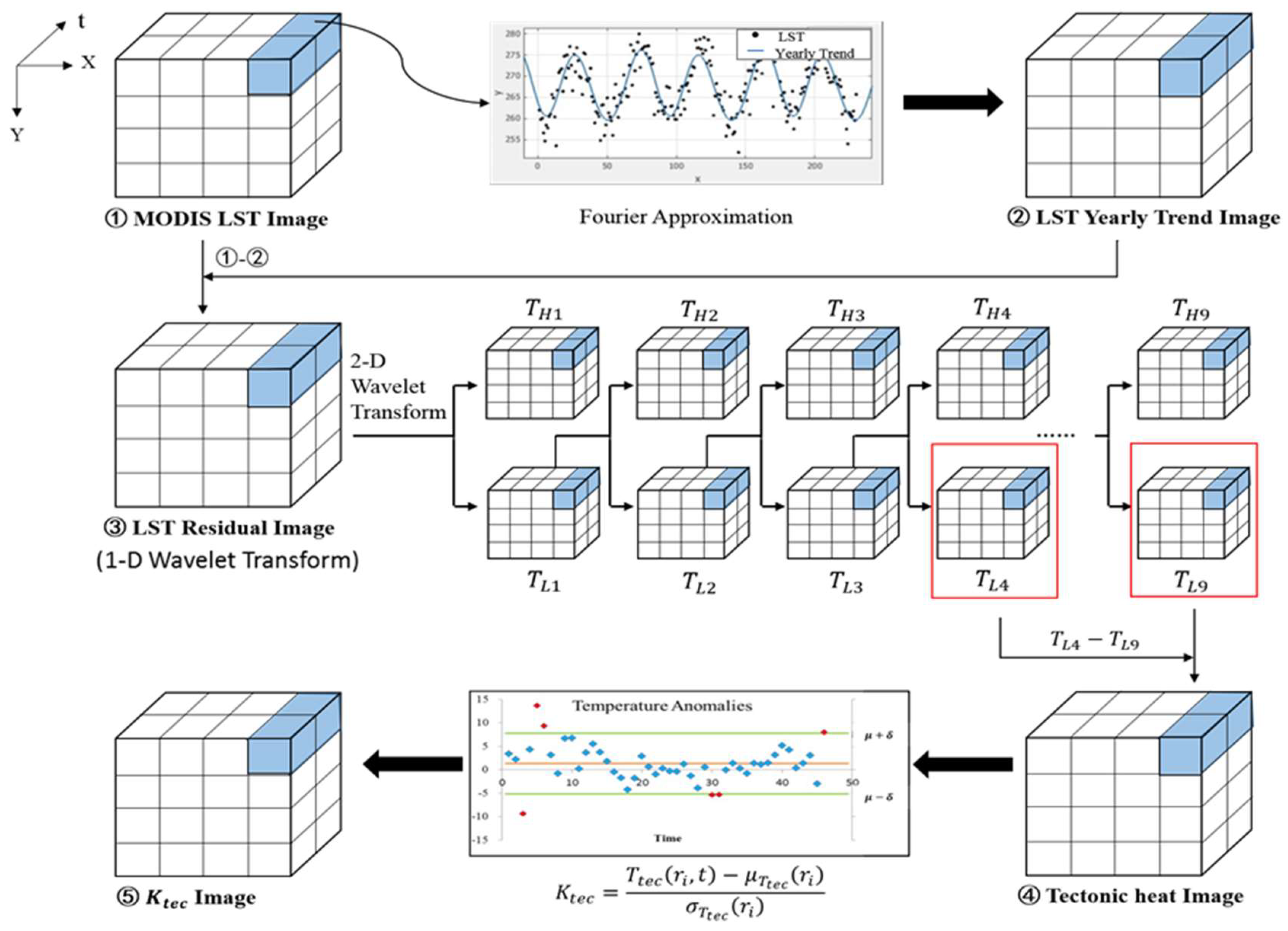
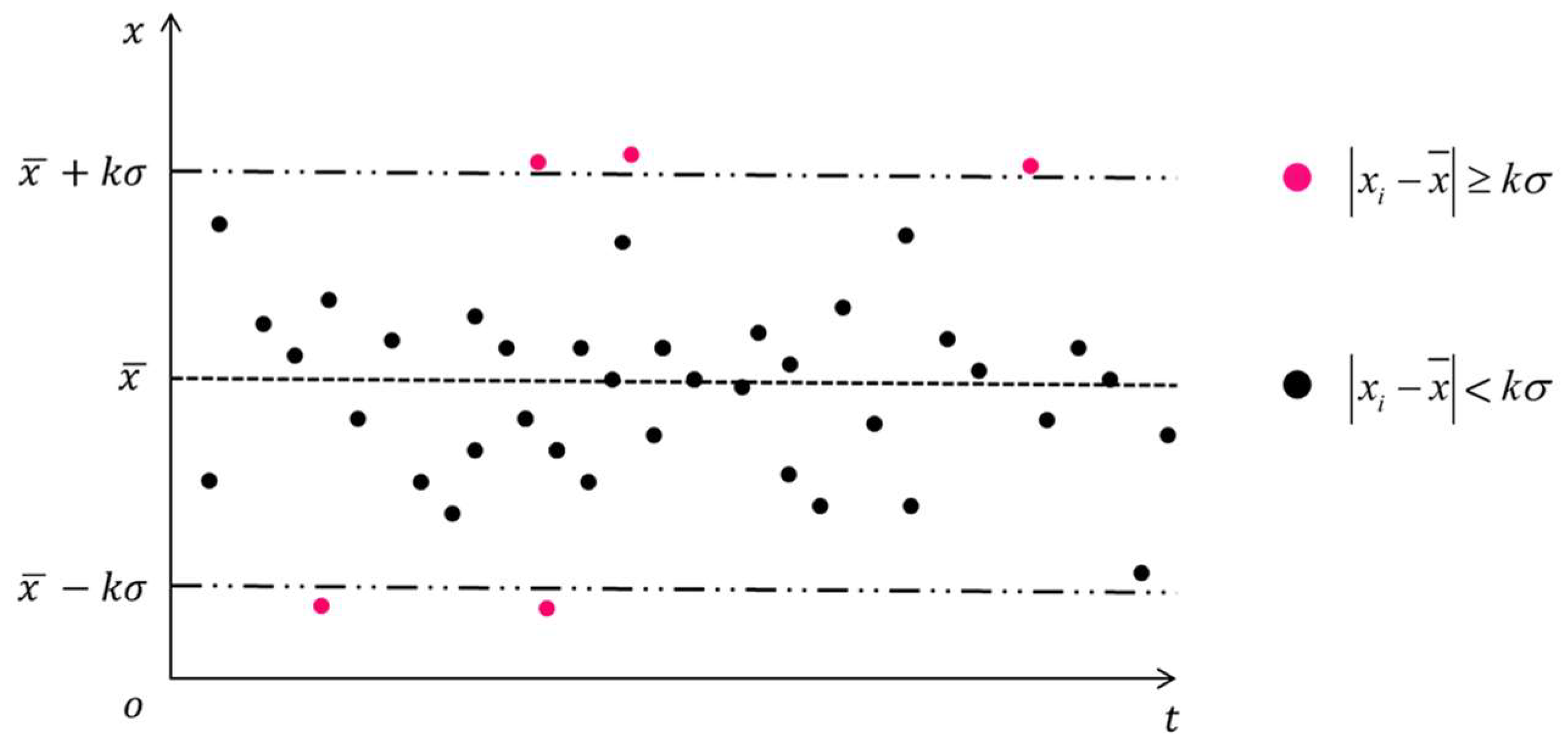
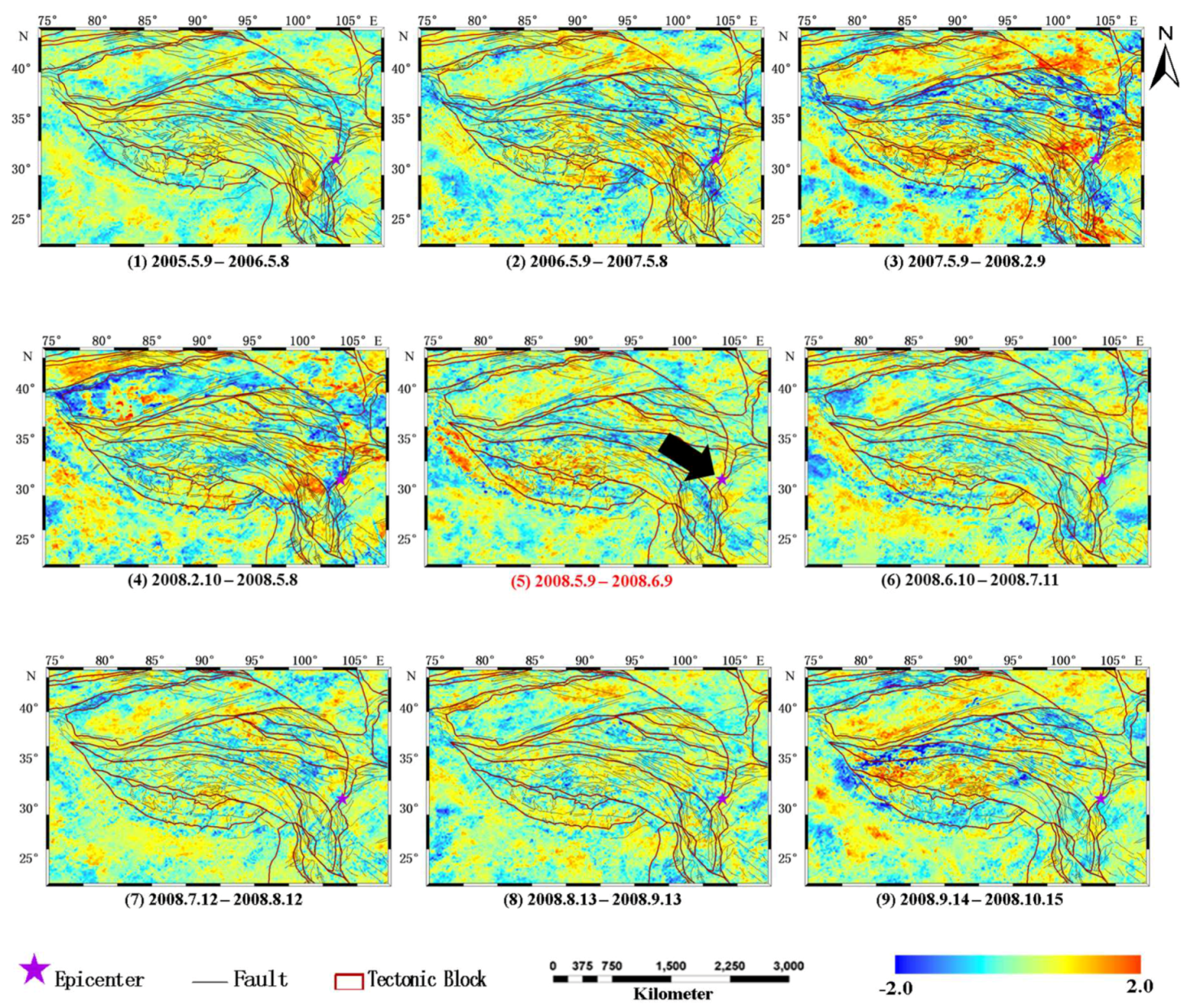
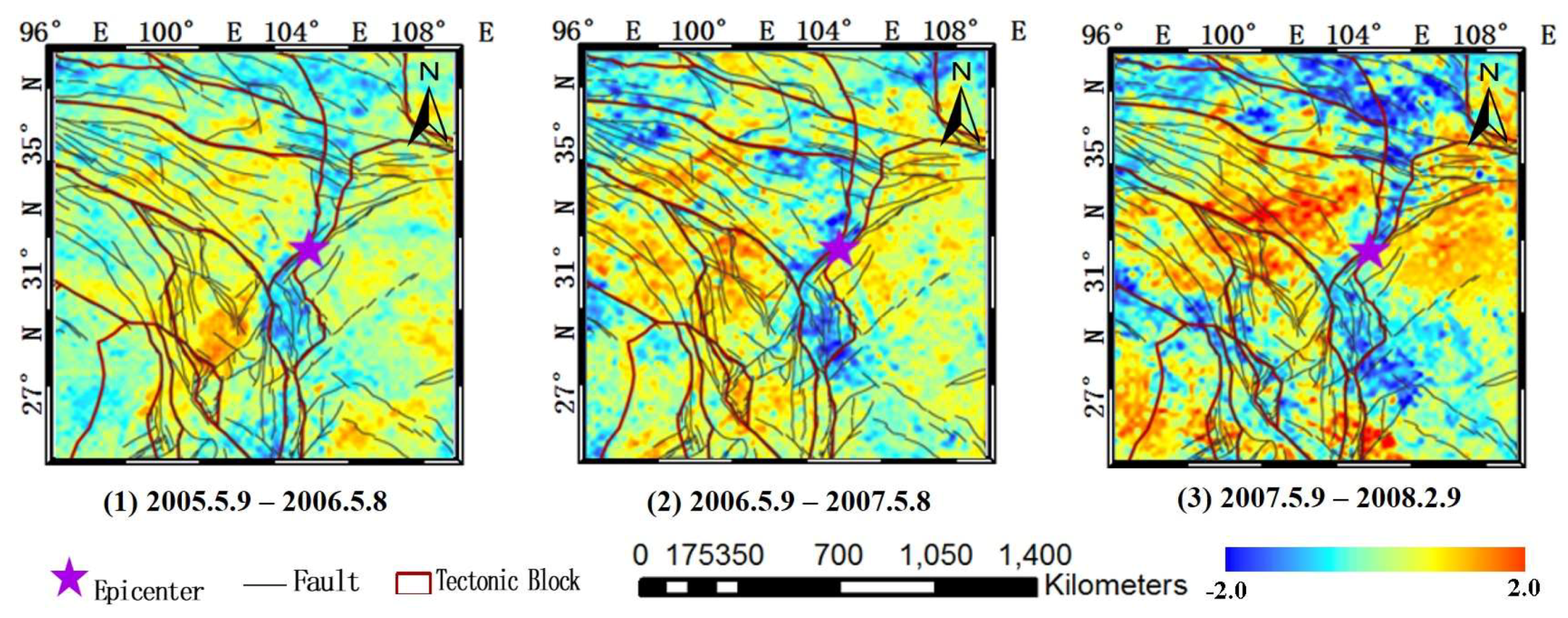


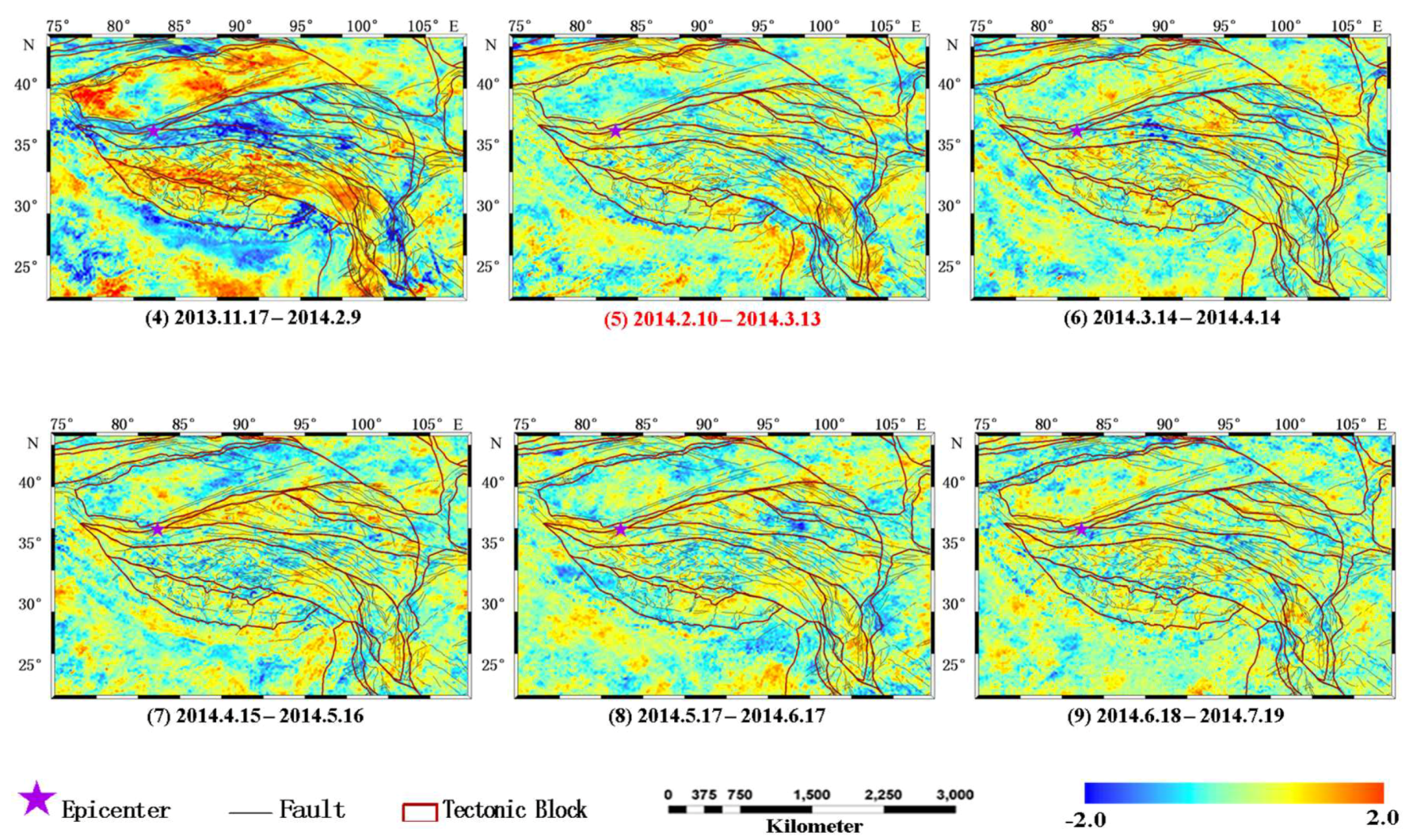
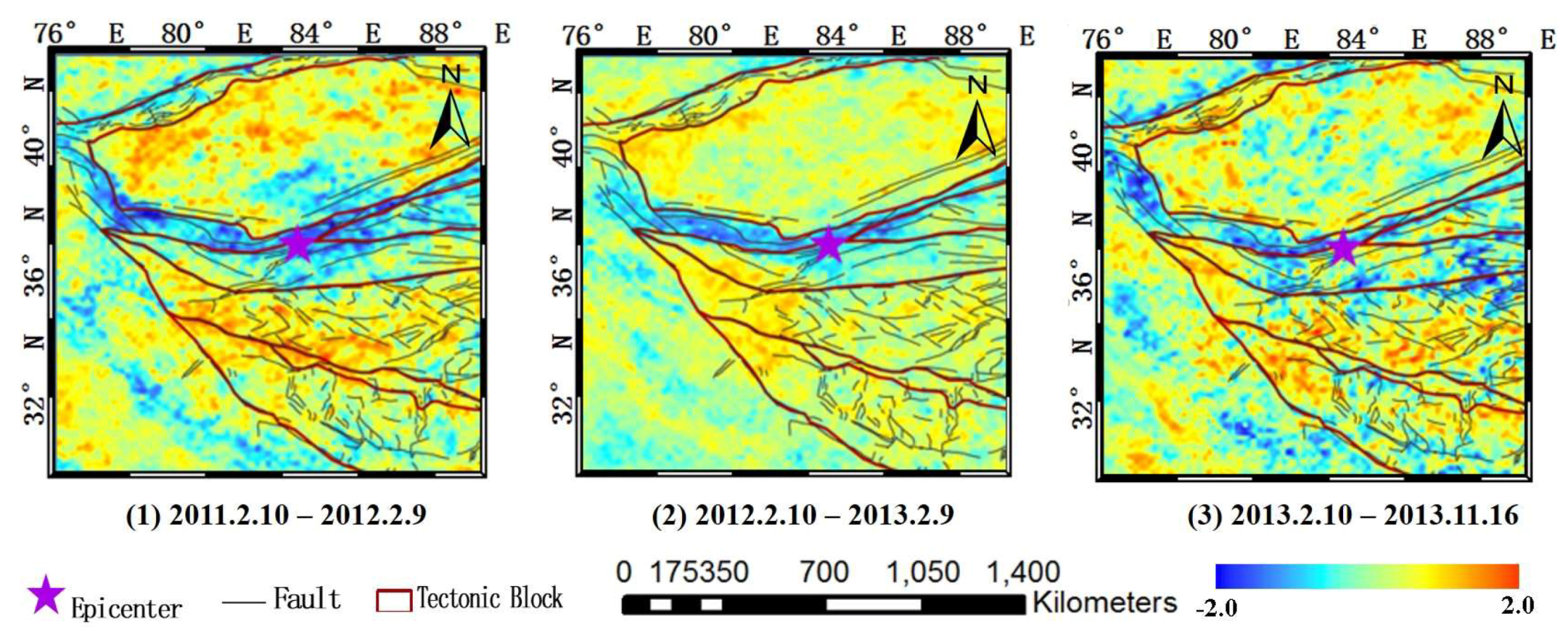
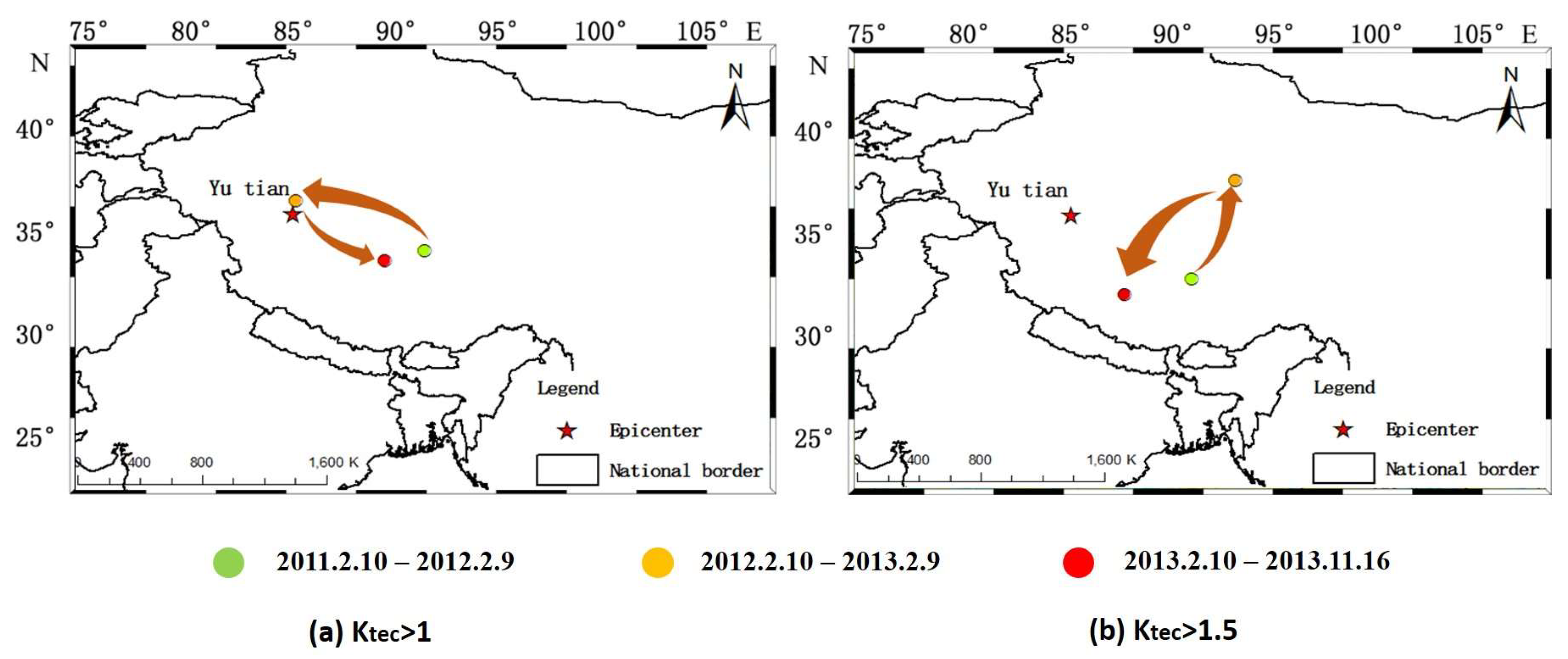
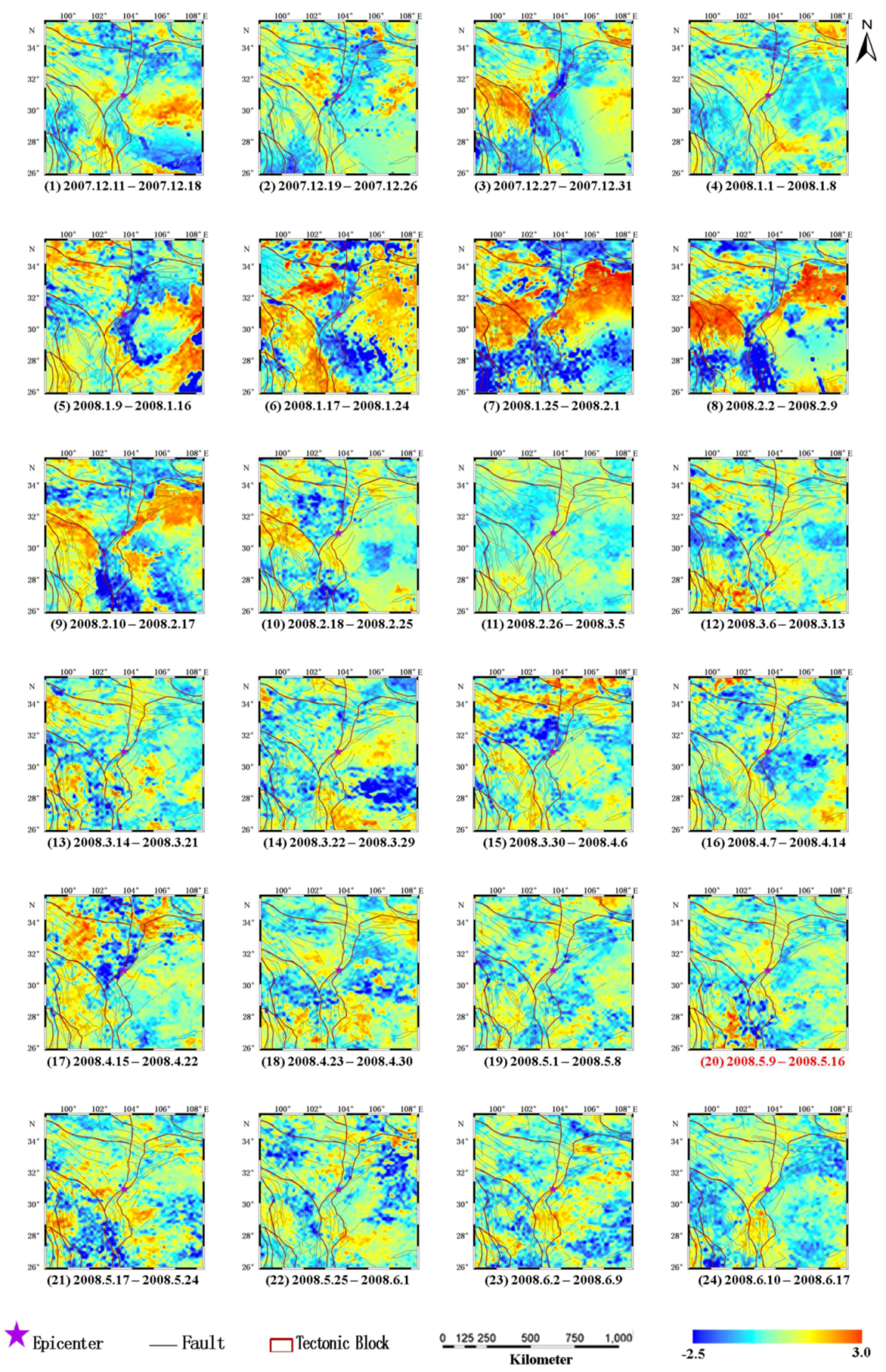
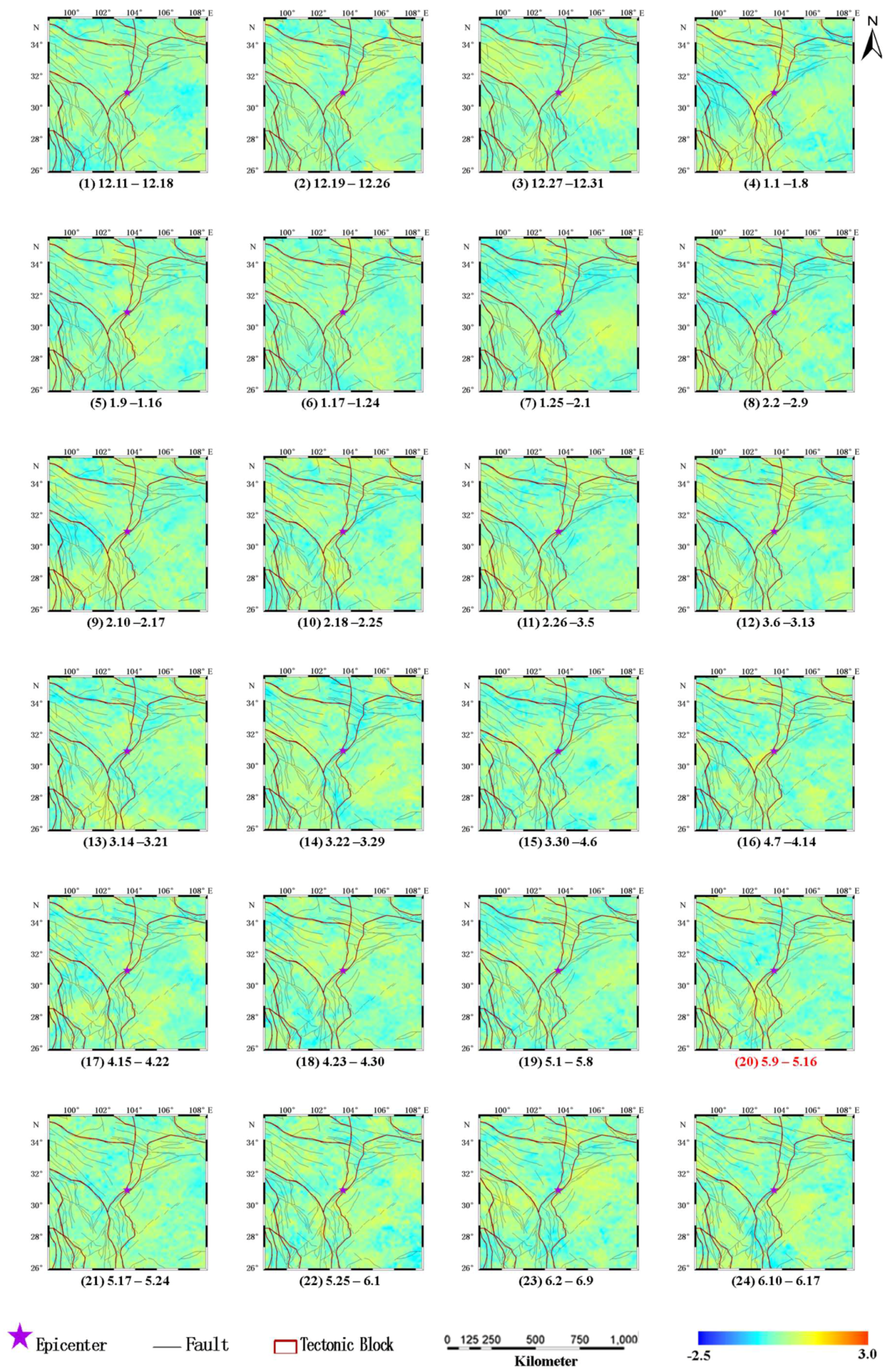
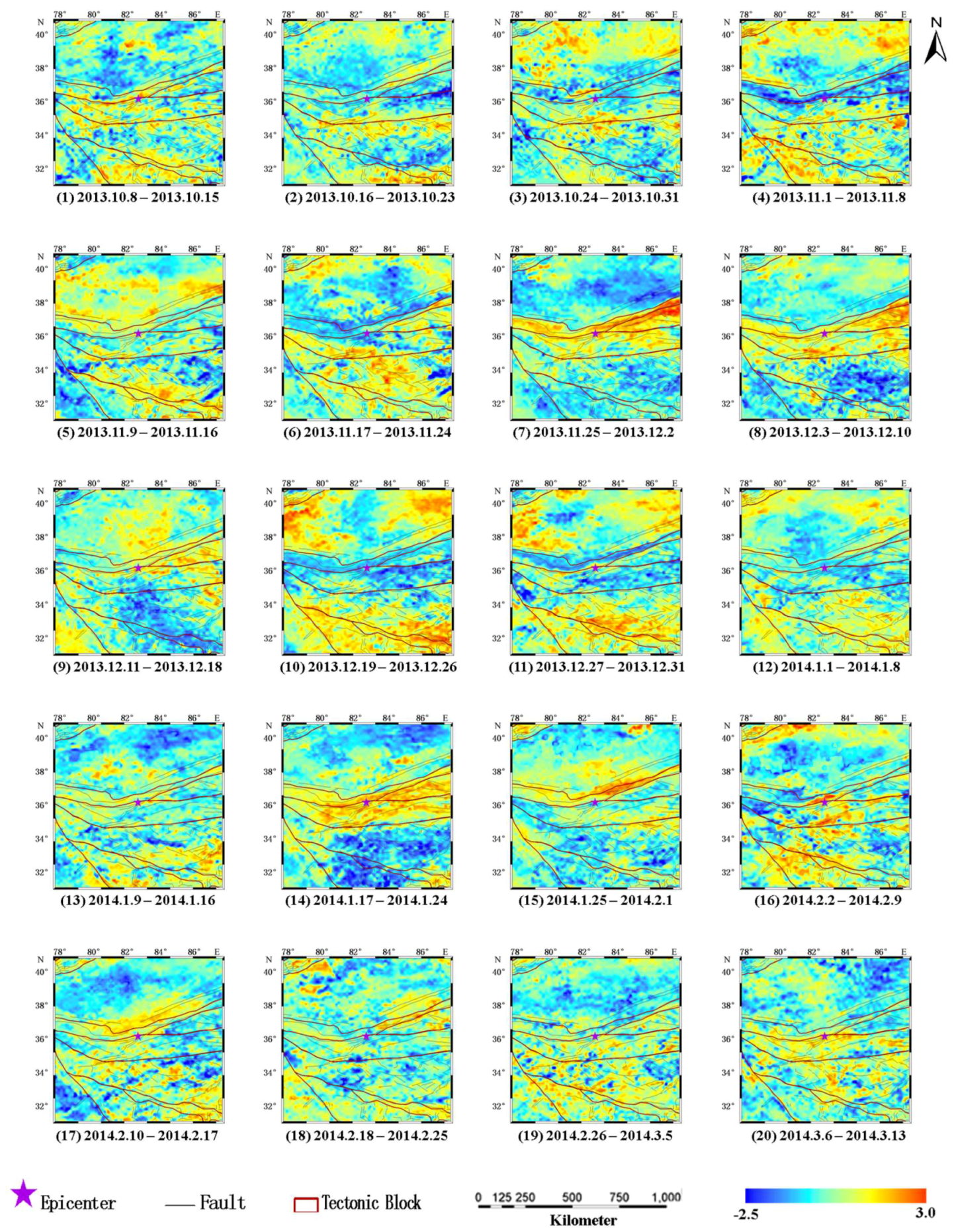

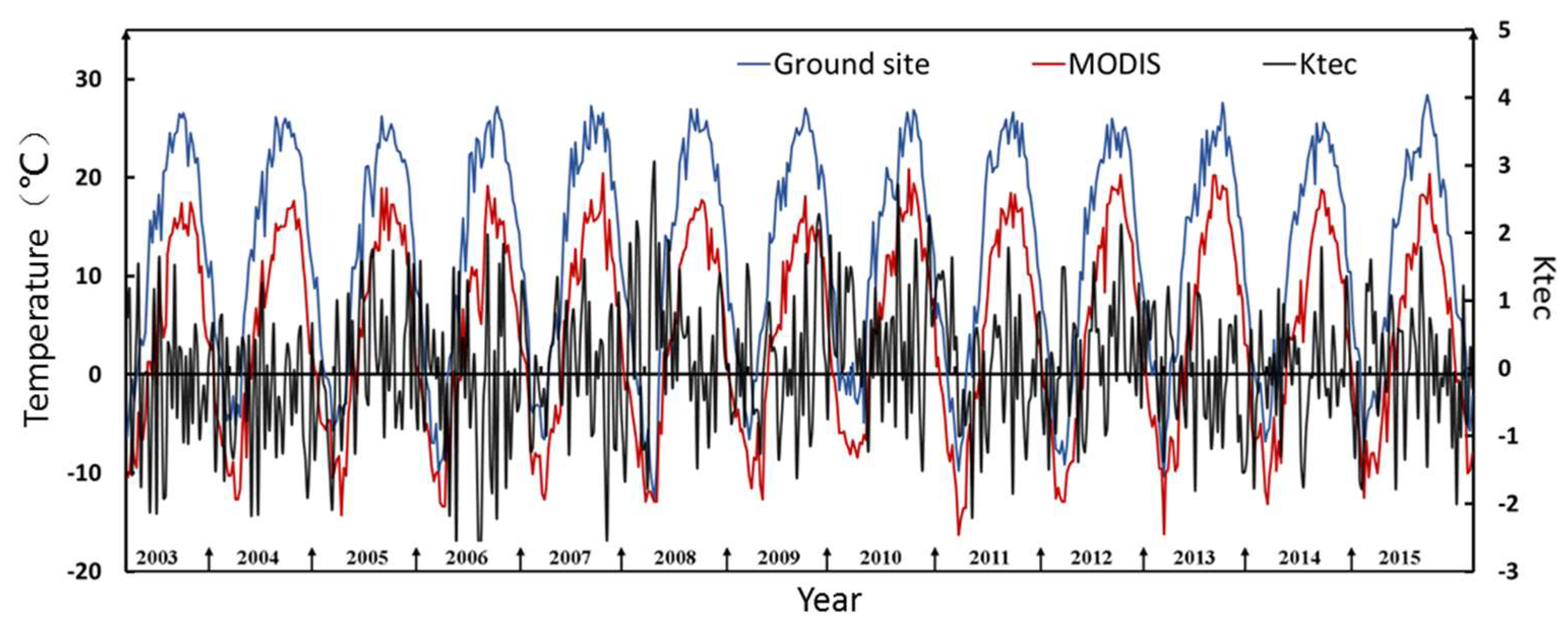
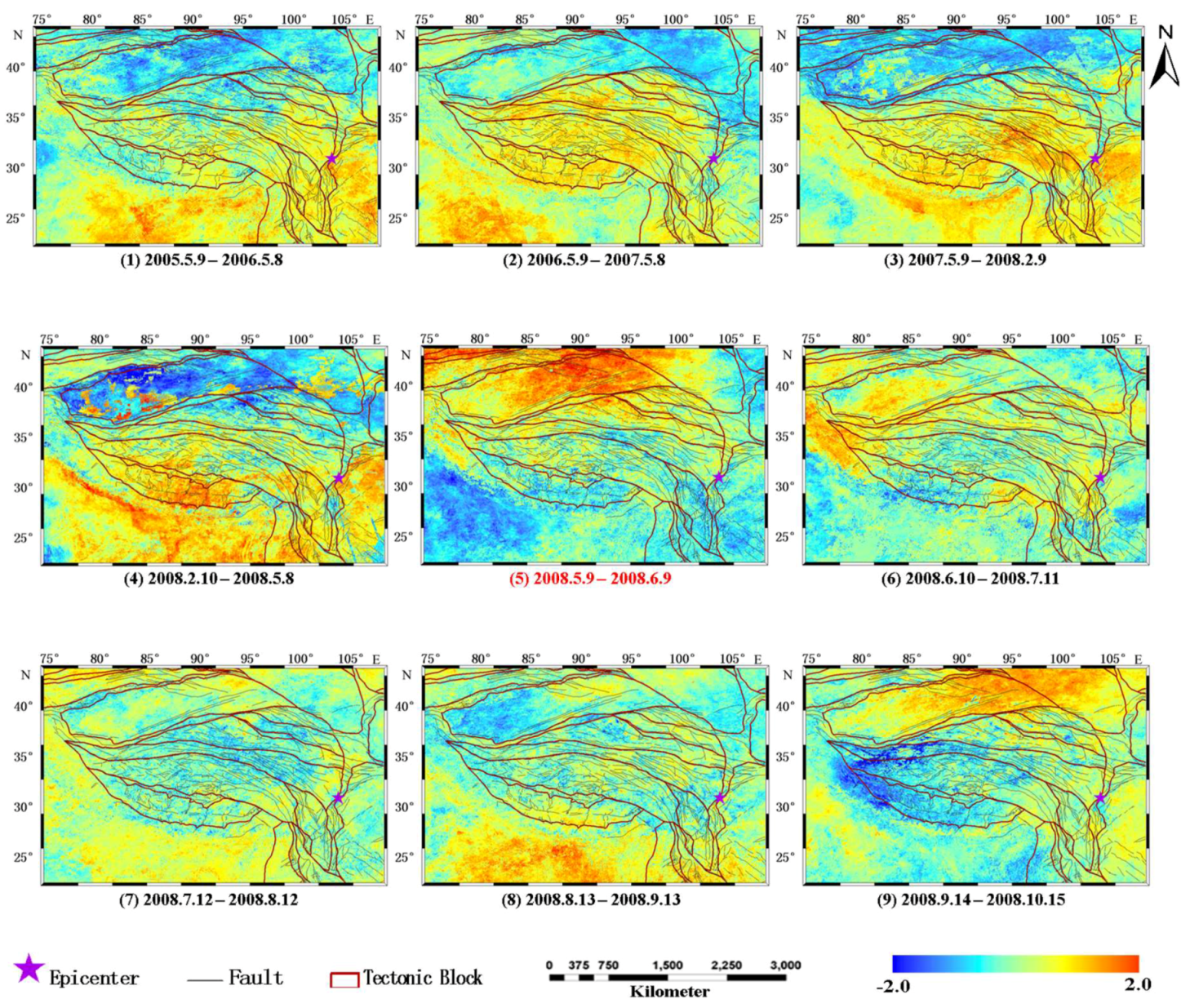
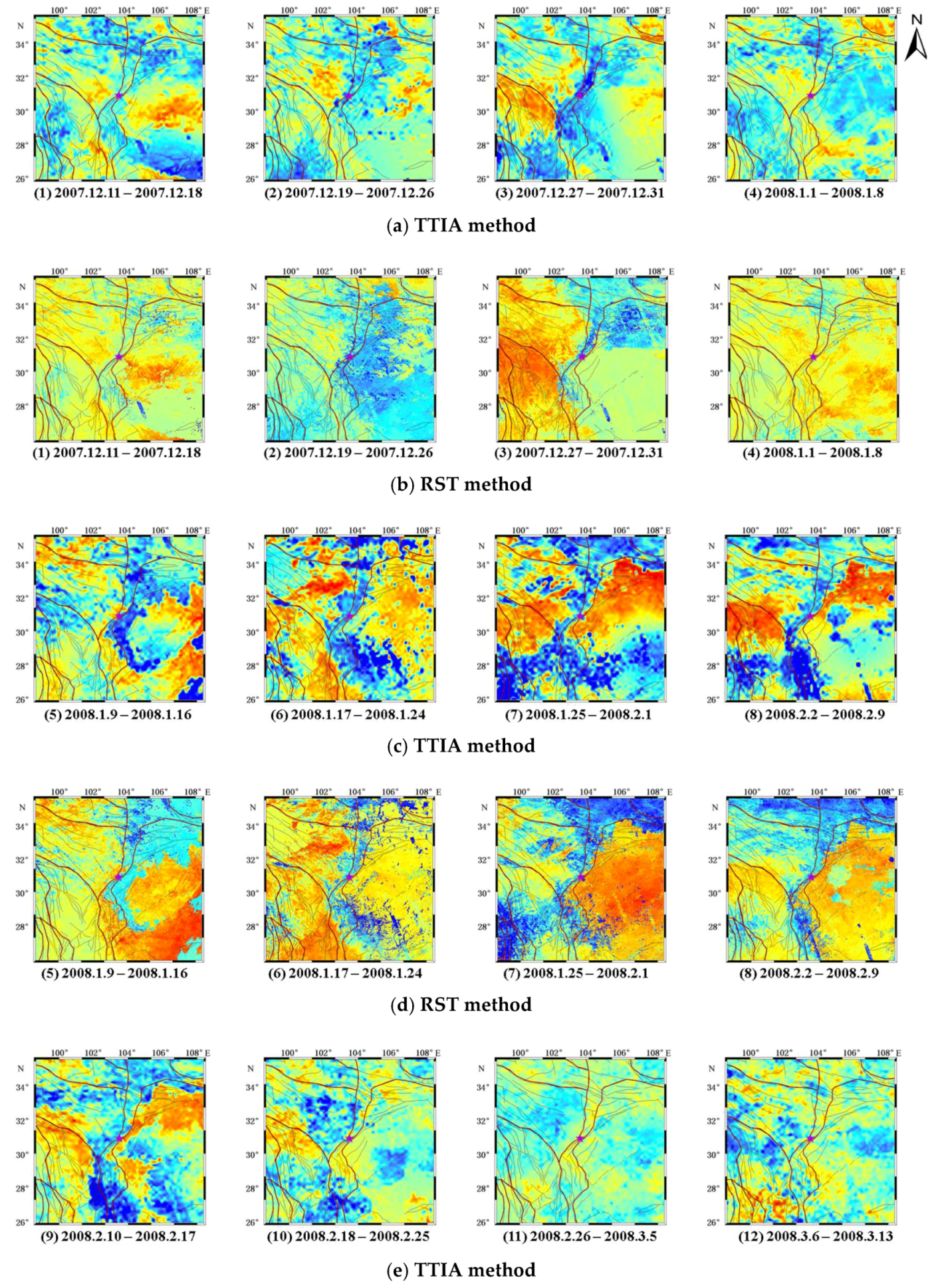
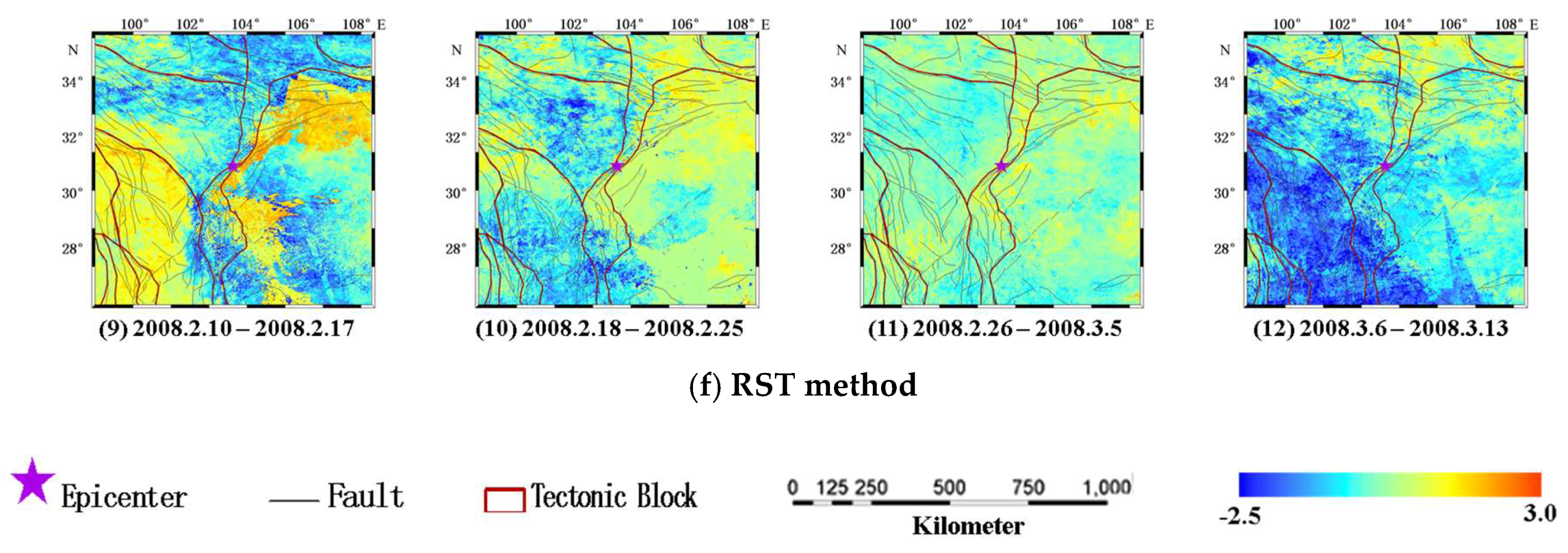
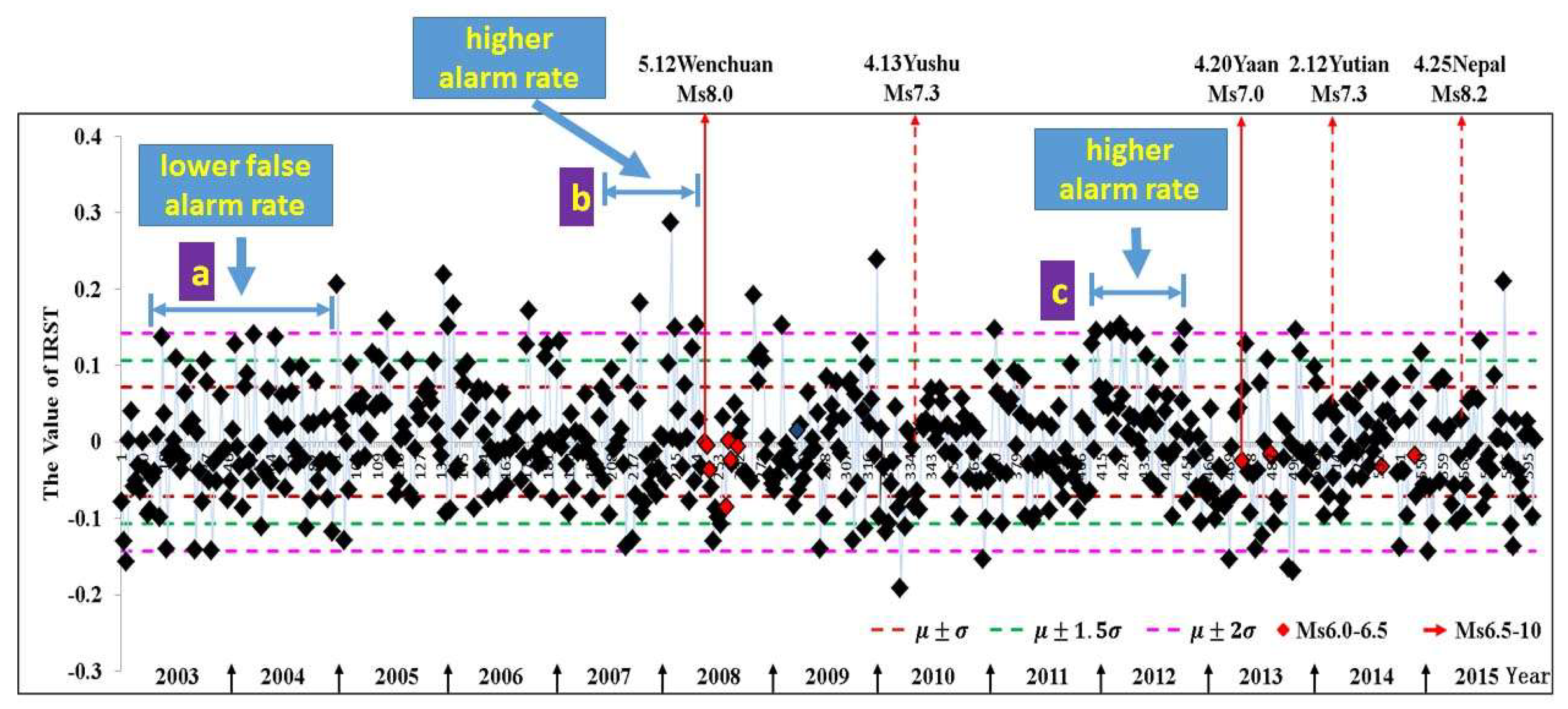
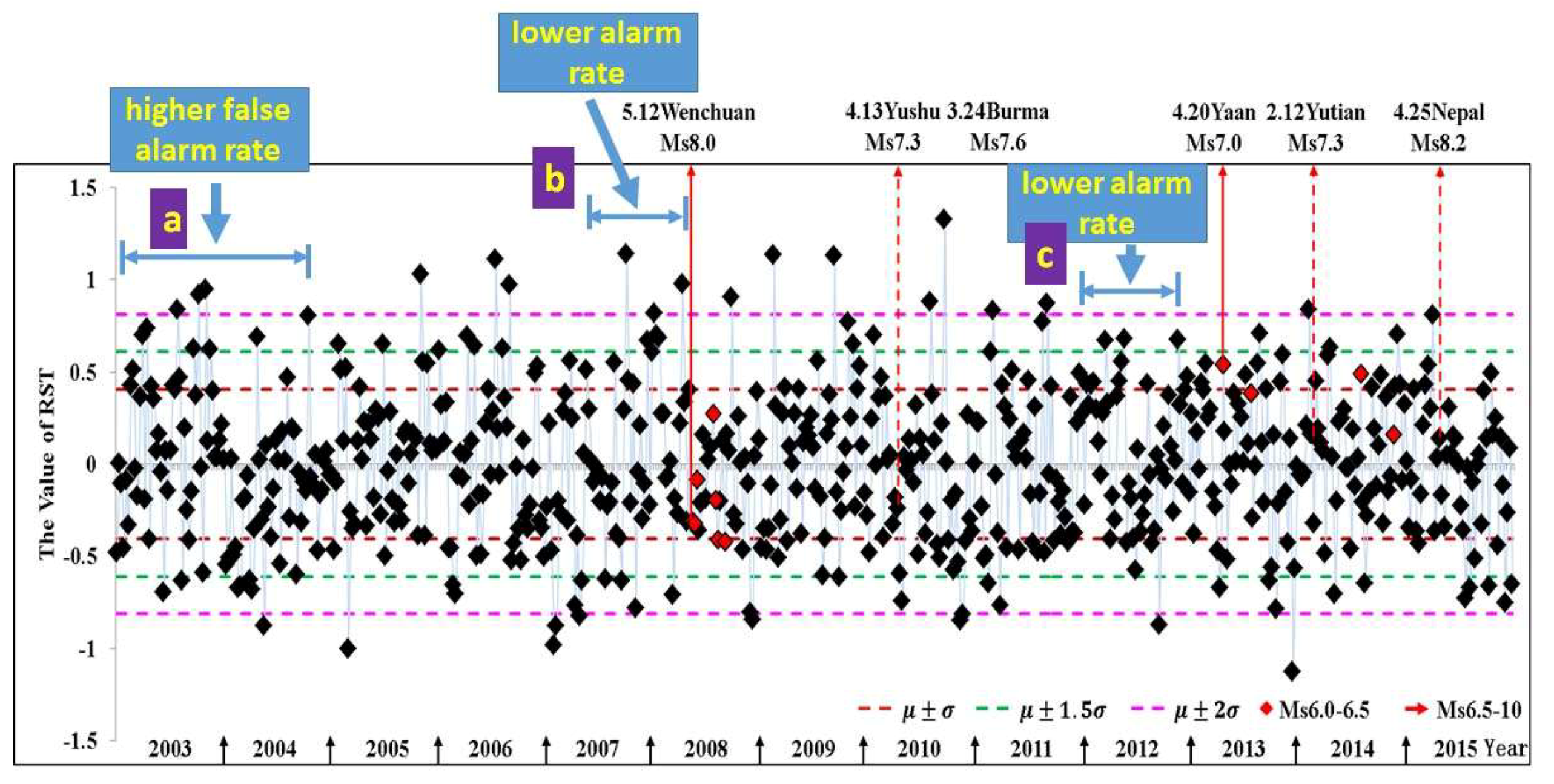
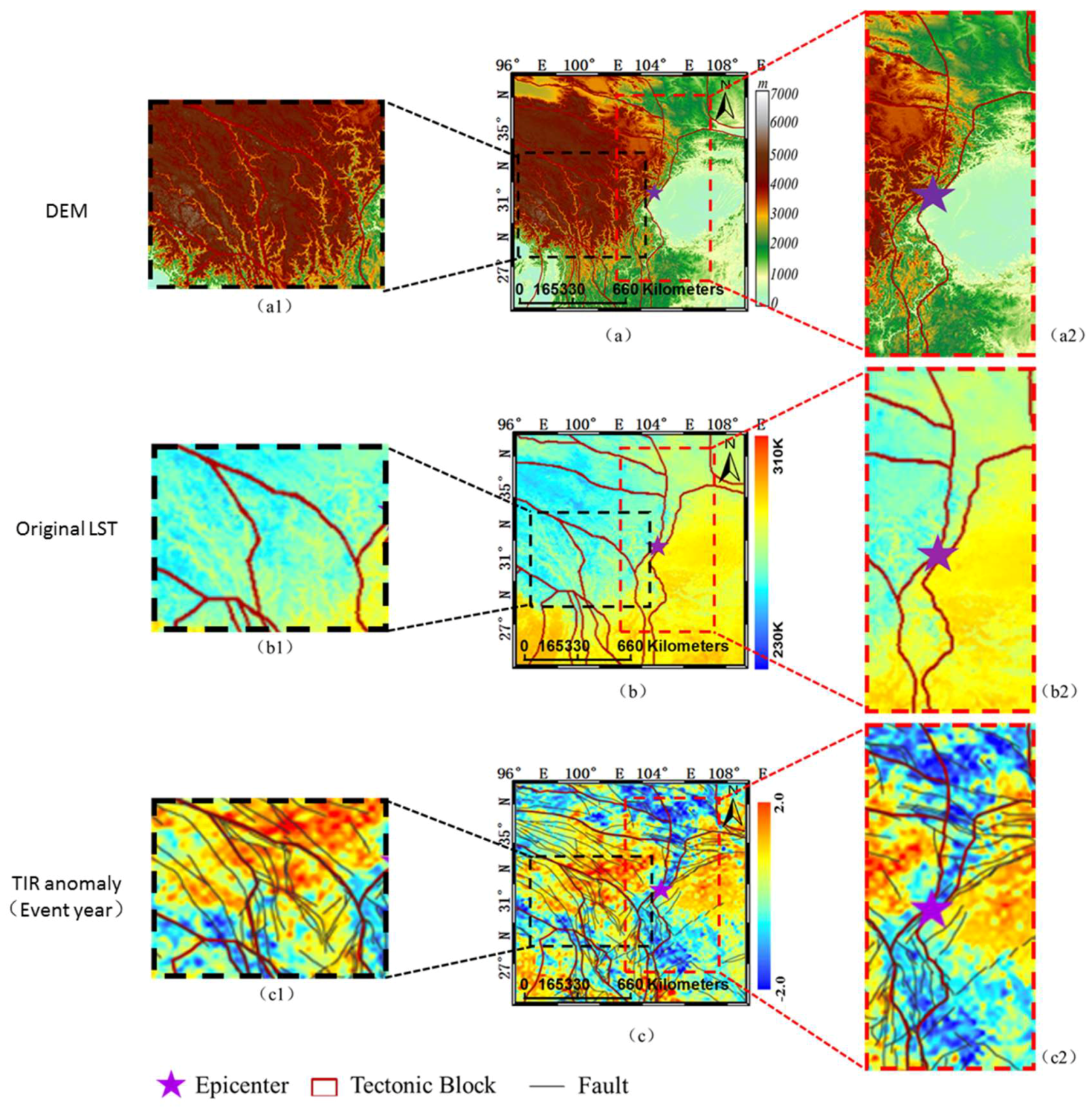
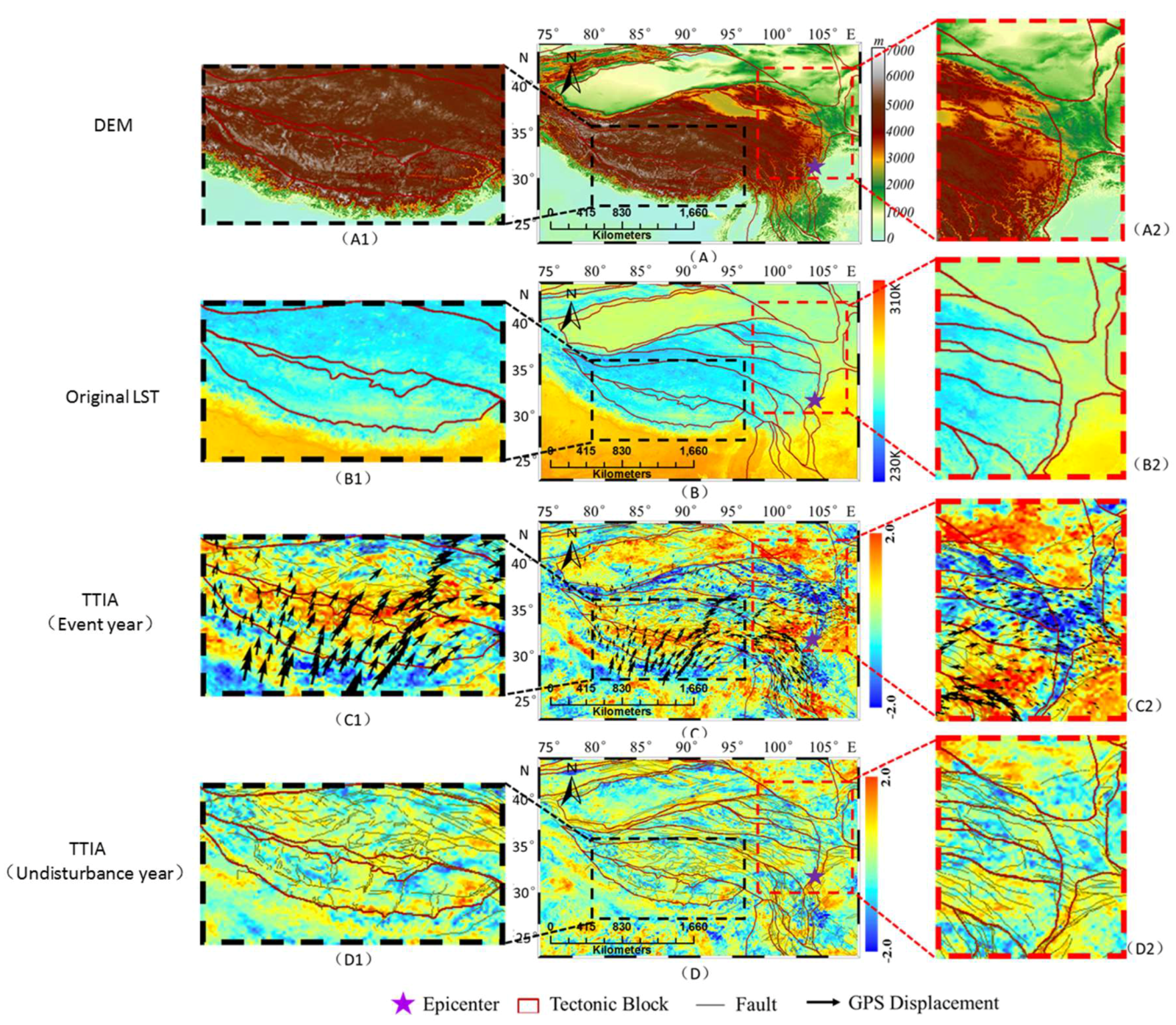
| Name | Data Type | Effective Numerical Range | Unit | Filling Values | Calibration Coefficient |
|---|---|---|---|---|---|
| LST_Day_1 km: 8-Day daytime 1 km grid LST | 16-bit unsigned int | 7500–65535 | K | 0 | 0.02 |
| QC_Day: Quality control for daytime LST and emissivity | 8-bit unsigned int | 0–255 | |||
| Day_view_time: Average time of daytime LST observation | 8-bit unsigned int | 0–240 | h | 255 | 0.1 |
| Day_view_angle: Average view zenith angle of daytime LST | 8-bit unsigned int | 0–130 | Degree | 255 | 1(-65) |
| LST_Day_1 km:8-Day nighttime 1 km grid LST | 16-bit unsigned int | 7500–65535 | K | 0 | 0.02 |
| QC_Day: Quality control for nighttime LST and emissivity | 8-bit unsigned int | 0–255 | |||
| Day_view_time: Average time of nighttime LST observation | 8-bit unsigned int | 0–240 | h | 255 | 0.1 |
| Day_view_angle: Average view zenith angle of nighttime LST | 8-bit unsigned int | 0–130 | Degree | 255 | 1 (−65) |
| Emis_32: Band32 emissivity | 8-bit unsigned int | 1–255 | 0 | 0.002 (+0.49) | |
| Emis_31: Band31 emissivity | 8-bit unsigned int | 1–255 | 0 | 0.002 (+0.49) | |
| Clear_sky_days: the days in clear sky conditions and with valid LST | 8-bit unsigned int | 1–255 | 0 | ||
| Clear_sky_nights: the nights in clear sky conditions and with valid LST | 8-bit unsigned int | 1–255 | 0 |
© 2018 by the authors. Licensee MDPI, Basel, Switzerland. This article is an open access article distributed under the terms and conditions of the Creative Commons Attribution (CC BY) license (http://creativecommons.org/licenses/by/4.0/).
Share and Cite
Song, D.; Xie, R.; Zang, L.; Yin, J.; Qin, K.; Shan, X.; Cui, J.; Wang, B. A New Algorithm for the Characterization of Thermal Infrared Anomalies in Tectonic Activities. Remote Sens. 2018, 10, 1941. https://doi.org/10.3390/rs10121941
Song D, Xie R, Zang L, Yin J, Qin K, Shan X, Cui J, Wang B. A New Algorithm for the Characterization of Thermal Infrared Anomalies in Tectonic Activities. Remote Sensing. 2018; 10(12):1941. https://doi.org/10.3390/rs10121941
Chicago/Turabian StyleSong, Dongmei, Ruihuan Xie, Lin Zang, Jingyuan Yin, Kai Qin, Xinjian Shan, Jianyong Cui, and Bin Wang. 2018. "A New Algorithm for the Characterization of Thermal Infrared Anomalies in Tectonic Activities" Remote Sensing 10, no. 12: 1941. https://doi.org/10.3390/rs10121941
APA StyleSong, D., Xie, R., Zang, L., Yin, J., Qin, K., Shan, X., Cui, J., & Wang, B. (2018). A New Algorithm for the Characterization of Thermal Infrared Anomalies in Tectonic Activities. Remote Sensing, 10(12), 1941. https://doi.org/10.3390/rs10121941





